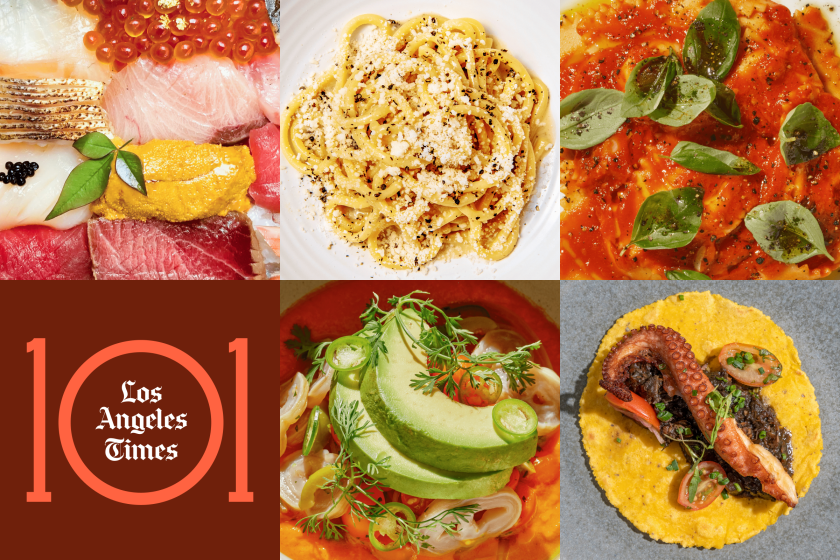Hall of Fame restaurants: These timeless classics define L.A. dining
Among our region’s profound dining possibilities, a handful of restaurants become so entwined in our culture — so much a part of what it means to eat and live in Southern California — that they surpass the notion of annual list-making. They have a place of honor for all time. Here are the 10 matchless modern classics that join our Hall of Fame this year, plus the names of 23 previous inductees in 2019 and 2022.
If you’re searching for the essential food of L.A., let our critic’s 2023 restaurant list be your guide! Find the best vegetarian, Japanese, Mexican cuisine and more.
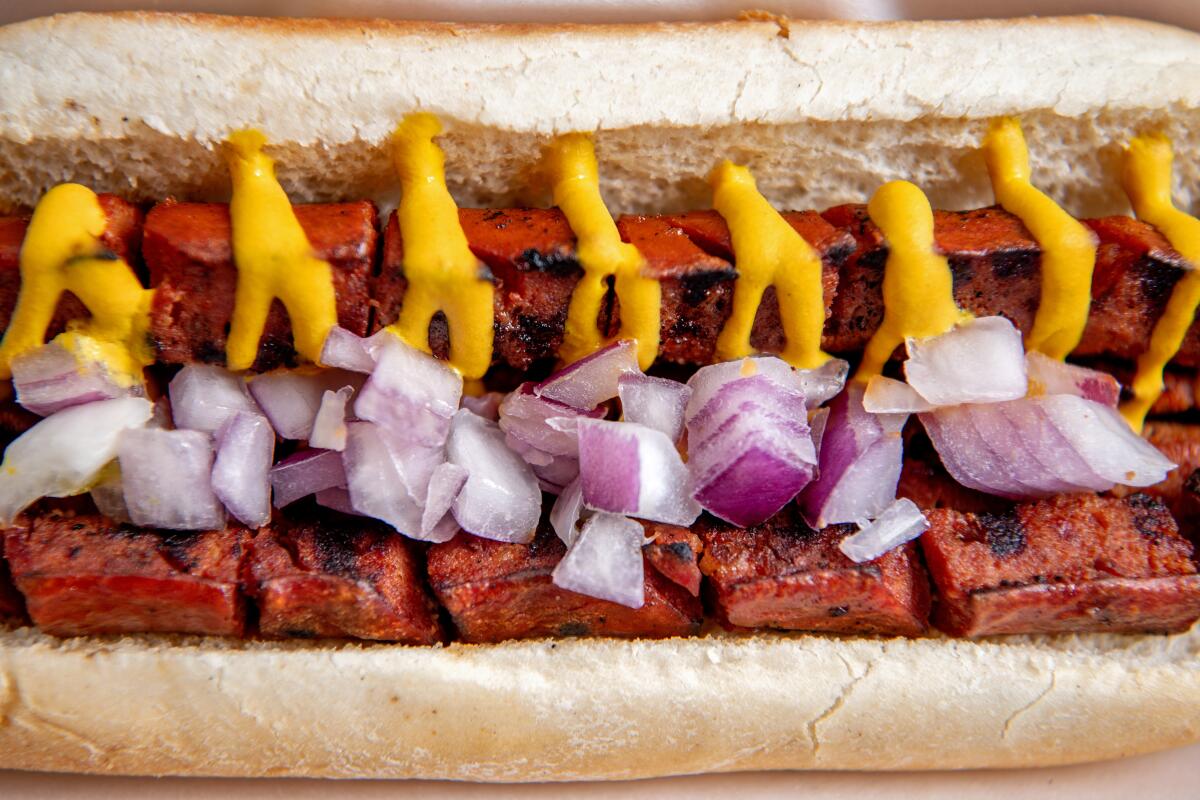
Earle's on Crenshaw
With nearly 20 options for hot dog toppings, it might take several trips to Earle’s to nail down your go-to order. Make mine a classic chili-cheese dog with raw onions. Generations of Angelenos know brothers Cary and Duane Earle, who began selling hot dogs in 1984 and opened their first stand-alone restaurant in 1992. Several locations later, settled on a well-trafficked stretch of Crenshaw Boulevard in Leimert Park, their storefront is a citywide favorite — including for vegans, with plant-based versions of Earle’s signature hot dogs, burgers and cheese fries. Who is that ray of sunshine radiating from behind the counter? The brothers’ mom, Hildred Earle-Brown, who as community grandmother seems to never forget a face.
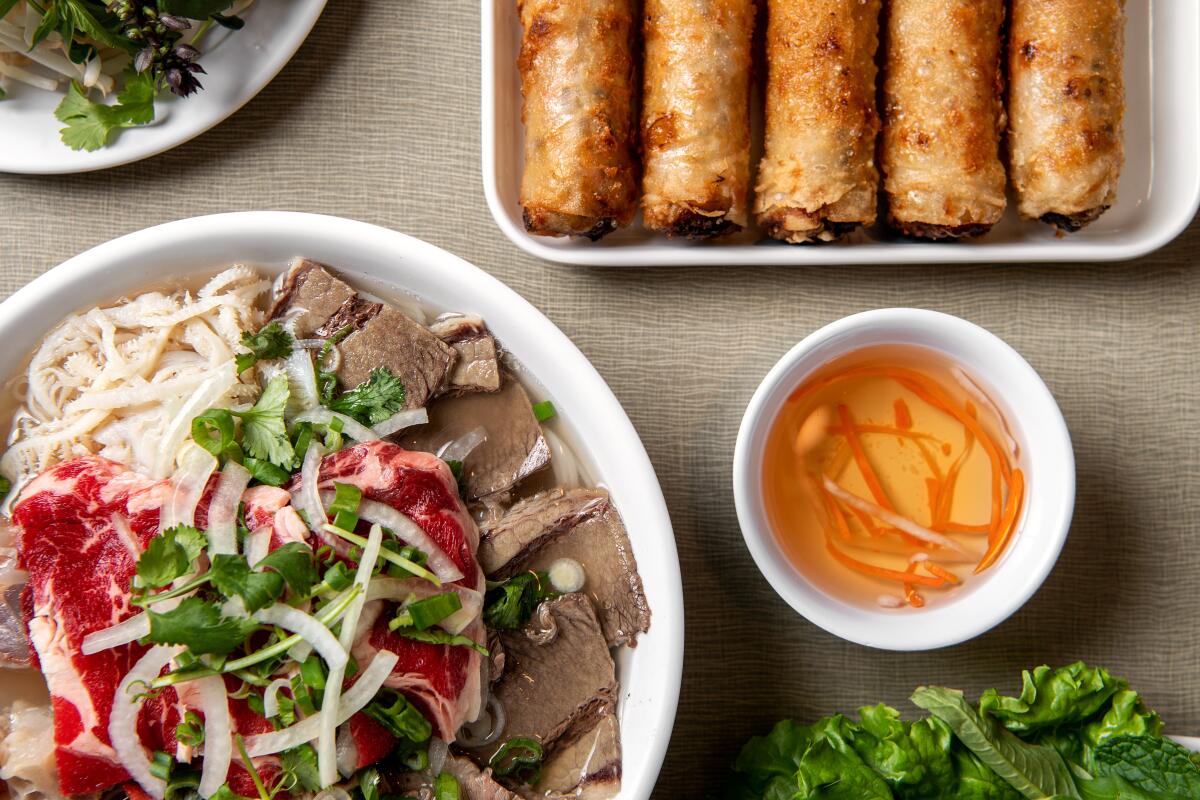
Golden Deli
These days the San Gabriel Valley is downright opulent with Vietnamese restaurants. Trieu and Lan Do laid the groundwork for the future riches in 1981, when they opened their first business in a San Gabriel strip mall. More than 40 years later, two things have stayed true: There will be a wait for a table (and the lounging chairs stationed outside along the sidewalk likely will be filled), and the room, whenever you are seated, will be filled with the audible crackling of cha gio. The craggy surface of the fried egg roll’s rice paper wrappers visually conveys “crunch” to the brain. Swaddling them in herbs and leaves only accentuates their texture. Golden Deli’s pho, skewered and grilled shrimp paste, banh mi and rice dishes are all dependable, but it is the cha gio for which you will return.
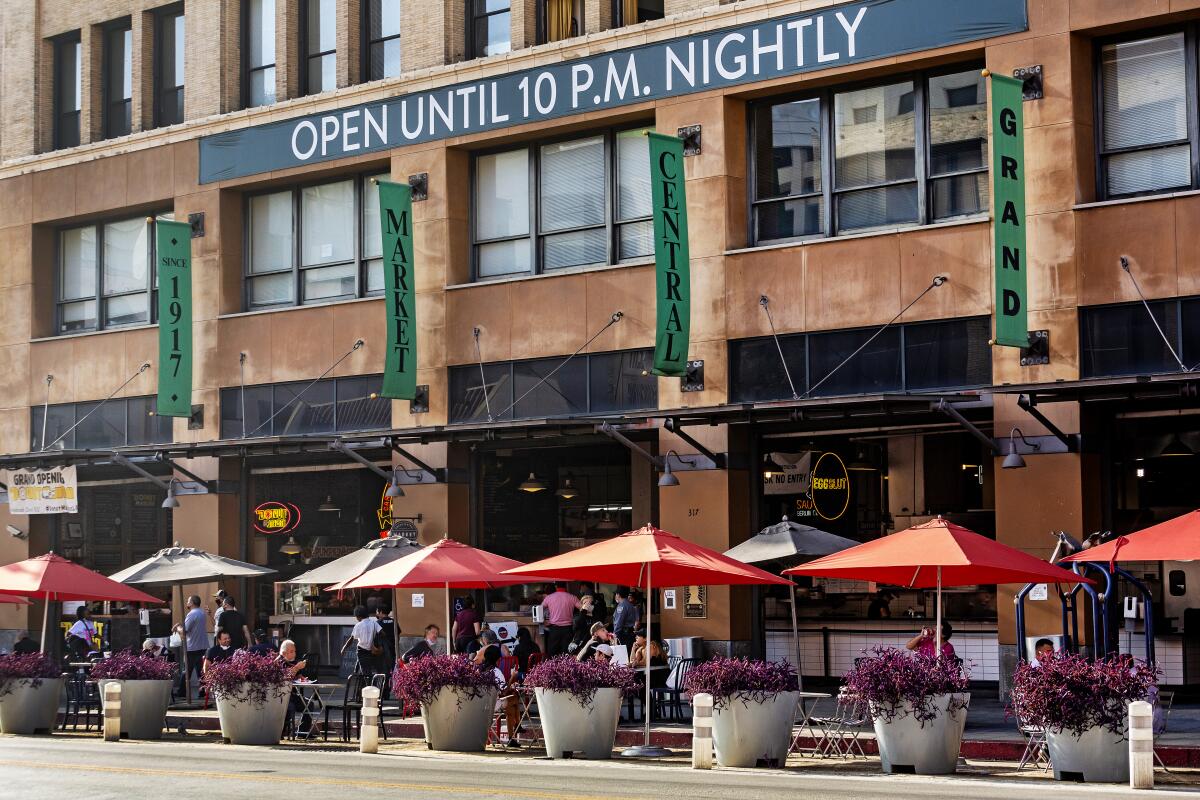
Grand Central Market
Downtown Los Angeles’ centenarian landmark stands at many crossroads: permanence and change, preservation and gentrification, the American Dream and capitalist reality, even shelter and open air. Arriving in its ecosystem is exhilarating. On weekends especially, you’re not so much walking among the vendors and neon signs as being swept along, like the surge through exits at the end of a Lakers game. Follow one row to pupusas revueltas with crisp, chile-speckled curtido at Sarita’s Pupuseria and to Wexler Deli’s pastrami, sliced thick as blocks and layered with sauerkraut between slices of rye. Hang a tight corner for Shiku’s kimchi-braised pork belly and pie jeweled with the moment’s fruits at Fat + Flour. What’s the market’s latest breakout star? Head around another bend to find out.
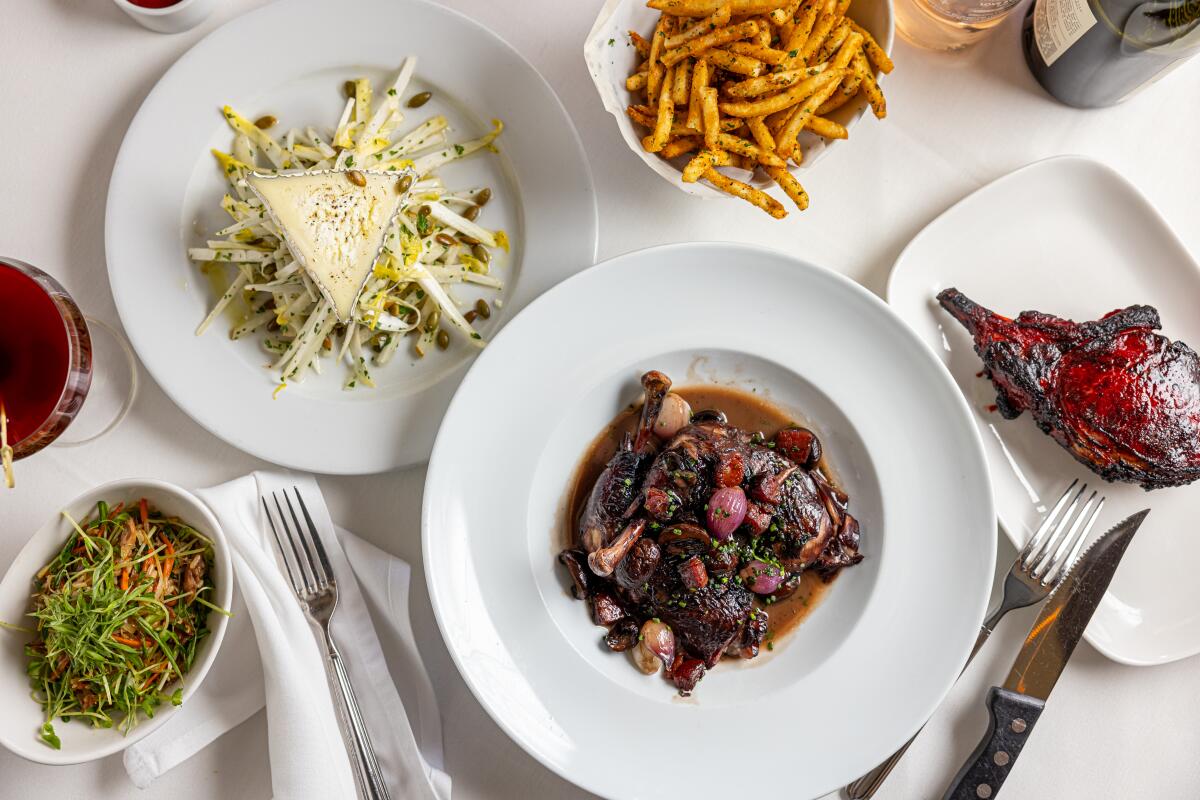
Jar
Suzanne Tracht opened Jar in Beverly Grove in 2002, but it was built to feel timeless. No surprise that its ever-stunning dining room — a set piece of chic wood paneling, flying-saucer-shaped lighting fixtures and other Midcentury Modern adornments — has been a filming location for numerous television shows, including, yes, “Mad Men.” I thirst for a martini upon entering. The longtime star of her menu, which broadly follows a steakhouse format, is the pot roast, which transcends any clichés with its nuanced textures and faint sherry perfume. That said, it is also deeply comforting, as are fistfuls of fries with candied garlic and the silken chocolate pudding for dessert.
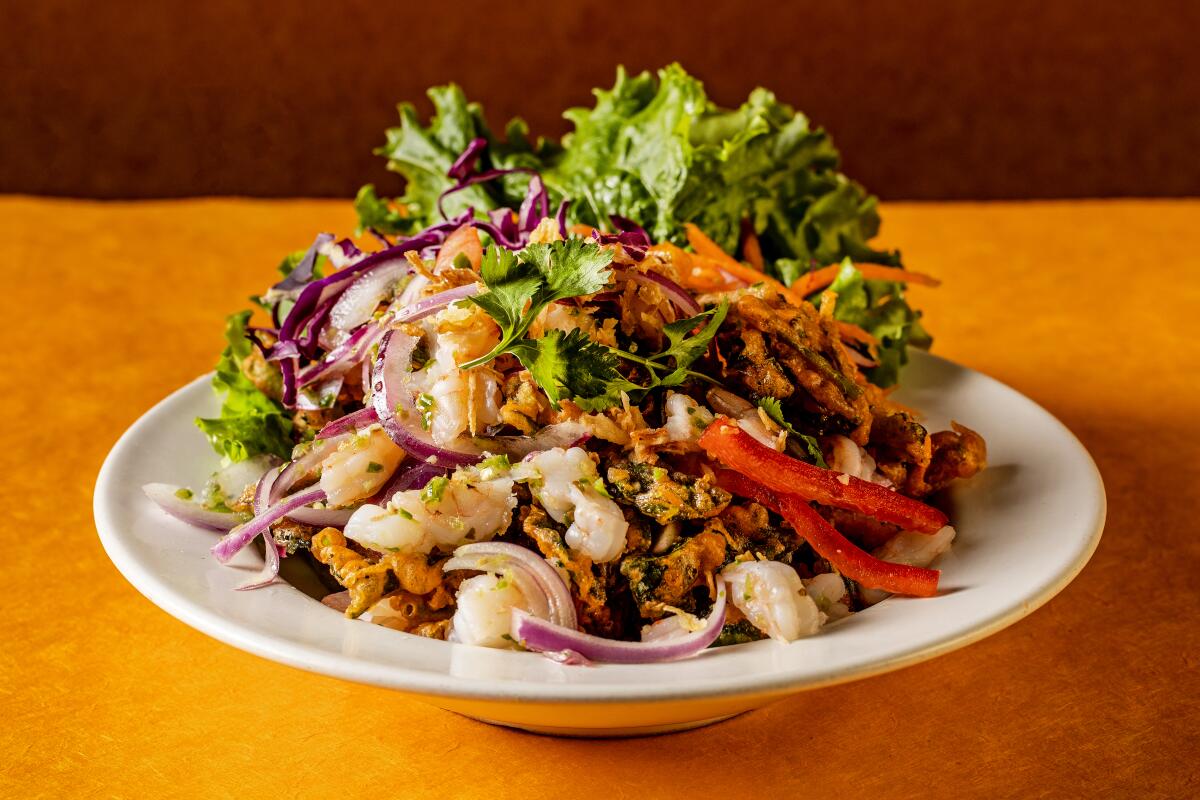
Jitlada
Few L.A. restaurant legends have endured like the story behind Jitlada: Chef Suthiporn “Tui” Sungkamee, who died in 2017, and his sister Sarintip “Jazz” Singsanong took over the long-running restaurant and introduced a then-untranslated back page full of radically spicy southern Thai specialties. Those dishes eventually were incorporated into the 10-page English menu, but their written accessibility doesn’t mean their incandescence has diminished. Some suggestions for jumping in: khua kling phat lung, a turmeric-stained beef curry; a salad of fried morning glory, plated so the stems look like they’re creeping over the edge of the bowl; and jungle curry with lamb, so ferocious with capsicums that the experience borders on supernatural possession. As a masterclass in regional Thai cooking, Jitlada is indispensable.
Watch more about Jitlada’s story.
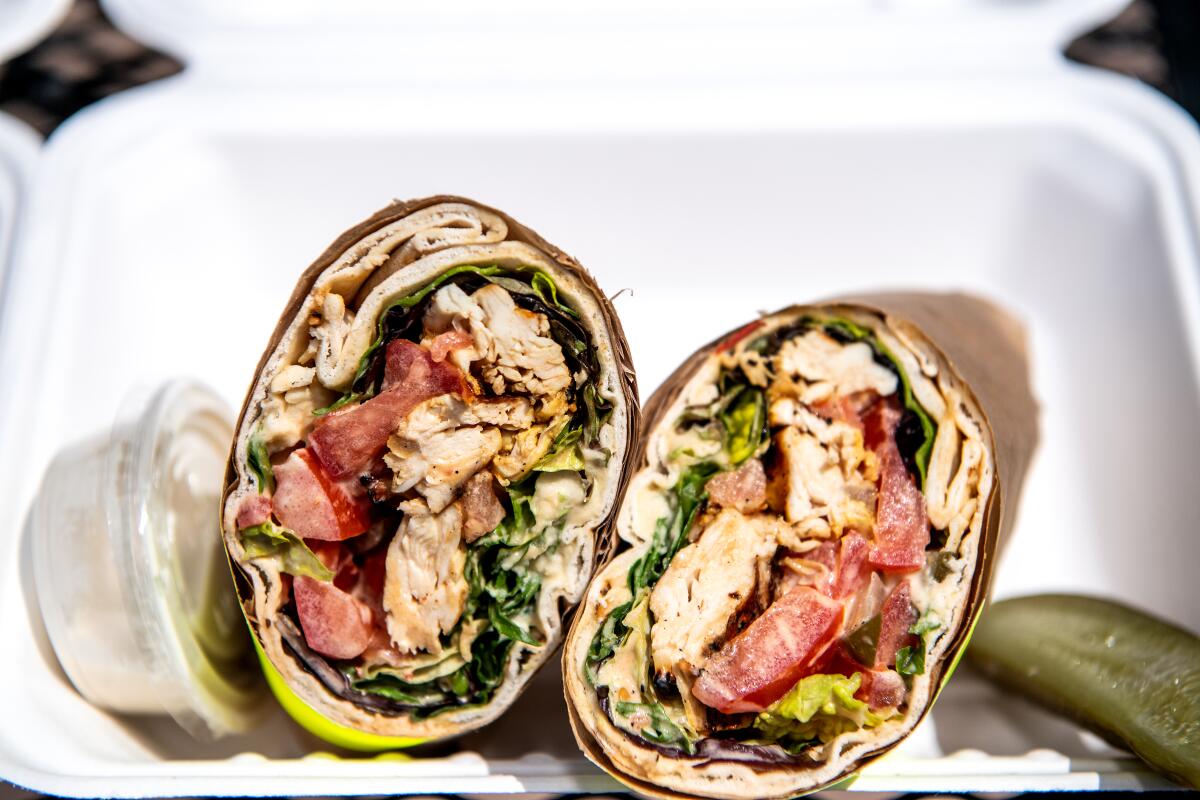
Kareem's Restaurant
Kareem’s, the Palestinian restaurant established by Mike Hawari and Nesrine Omari in 1996, technically sits just outside the mile-long stretch of Brookhurst Street that the Anaheim City Council designated as “Little Arabia” in summer 2022 after decades of lobbying. But the family business, now run by siblings Kareem Hawari and Nora Hawari, has long felt like a spiritual center of the neighborhood. Settle into a table on the plant-filled oasis of a patio for sustaining feasts of hummus, grape leaves, kebabs threaded with chicken and ground lamb and beef, minted yogurt with cucumber — and definitely falafel, crackly on the outside with an interior dyed spring-flush green from plenty of chopped parsley.
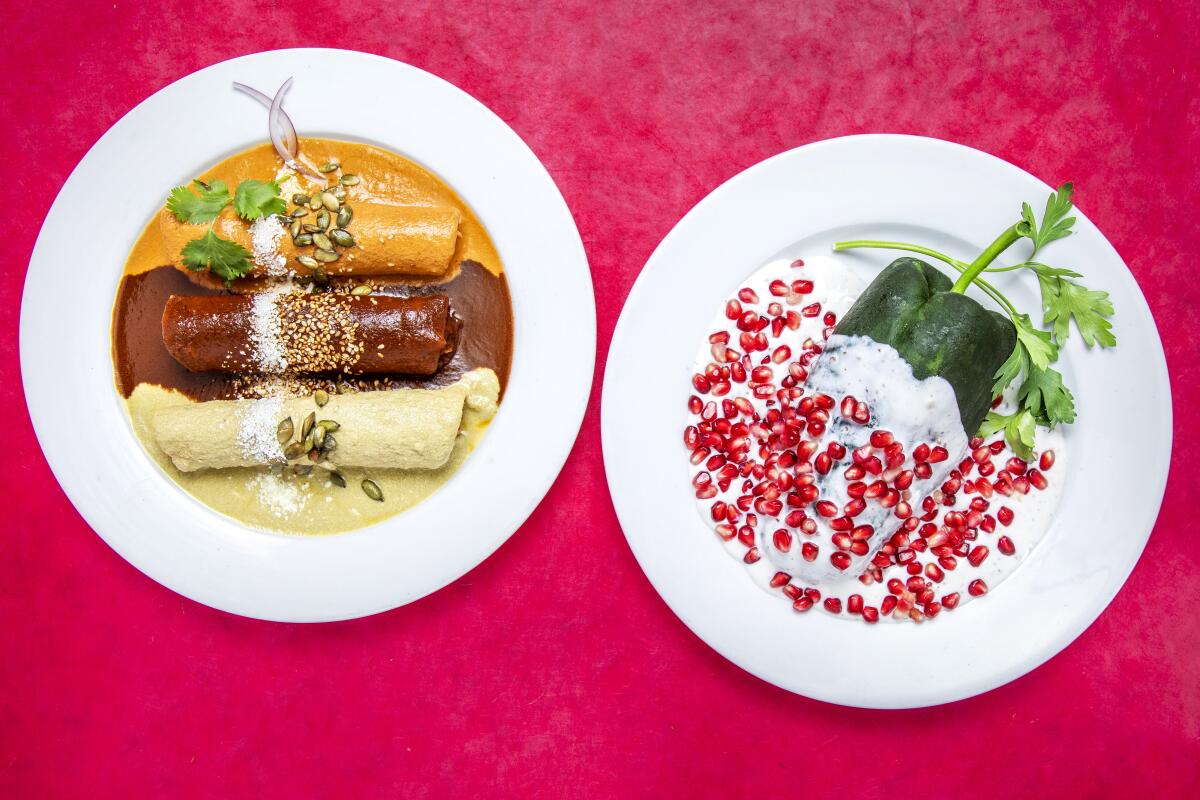
La Casita Mexicana
Jaime Martin del Campo and Ramiro Arvizu — who were both born in Jalisco, Mexico, and met in the 1990s in Los Angeles when they were executives at competing airlines — opened their Bell restaurant in 1999. With a menu crafted partly as a tribute to their grandmothers, highlighting sophisticated, labor-intensive dishes from various regions of Mexico, La Casita Mexicana blurred genres. Was it a neighborhood restaurant? A place that leaned to special occasions? It didn’t need a set label, and it became an institution. Their chile en nogada, with a ground beef stuffing that includes candied cactus and a snowy pecan cream sauce scattered with pomegranate seeds, has been legendary for years. Breakfast is a destination unto itself; follow the crowd and order a plate of the tricolor chilaquiles divorciados.
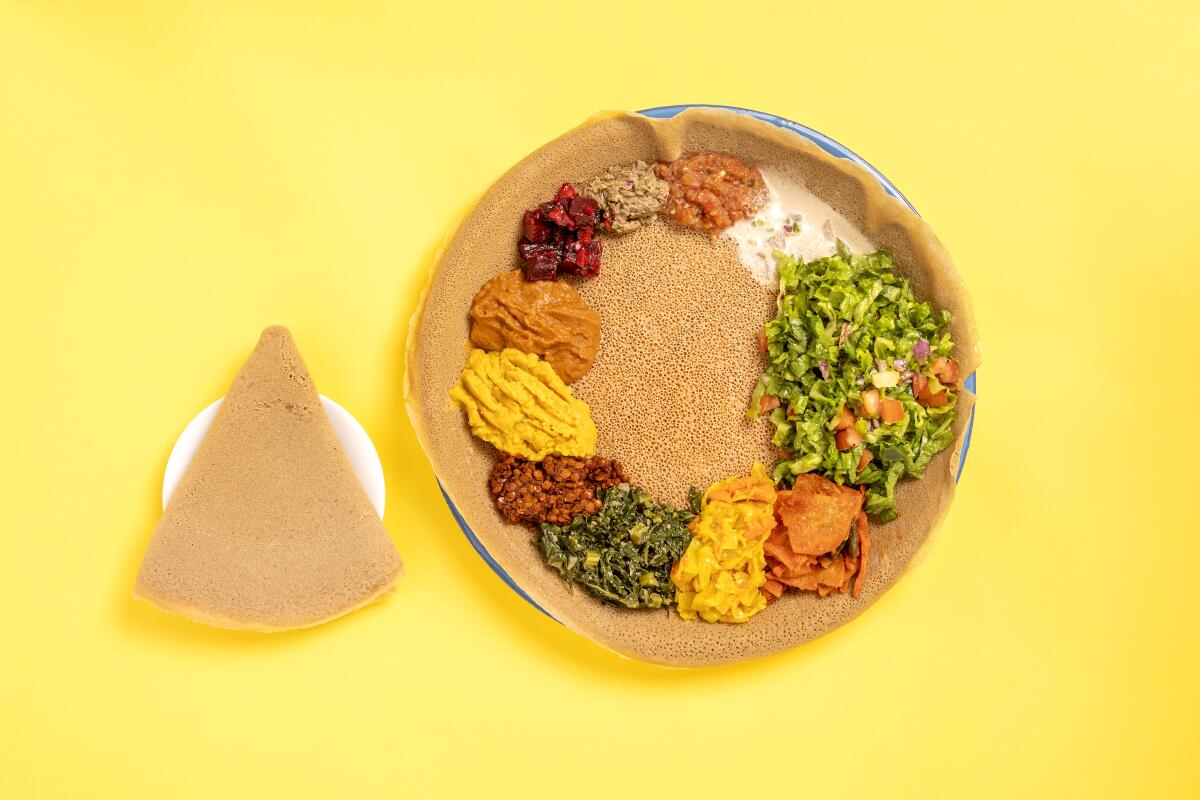
Meals by Genet
In her semi-retirement, Genet Agonafer prepares meals for takeout from her Little Ethiopia stalwart Thursday through Sunday and opens her once-bustling dining room for private events. The care in her food is as palpable as ever. Let’s never imagine a day without the restaurant’s doro wat, an indivisible sum of chicken, onions and profound berbere spices. Agonafer, who is vegan, creates a beautifully ordered landscape with her vegetarian platter: forest-green collards border earth tones of spiced lentils and split peas and marigold shades of turmeric-stained cabbage. Follow a similar path by adding an order of long-simmered foul warmed with green chile, or diverge with yebegsisga alitcha, a buttery and gently garlicky lamb stew.
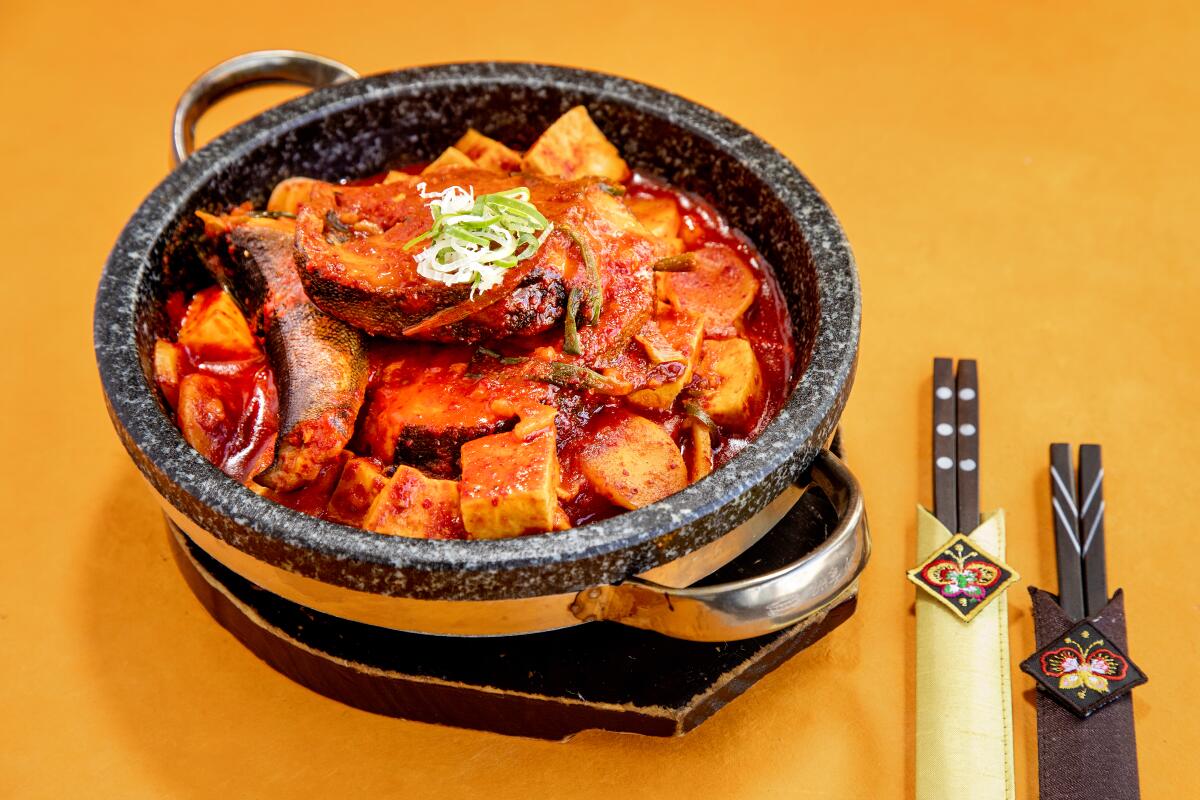
Park's BBQ
Literally dozens of barbecue houses line the streets of Koreatown. But for overall quality and hospitality, Jenee Kim’s operation has set the standard for decades. Come to Park’s with a group. A meal goes by in an exhilarating blur of fellowship and meat. The “Taste of Park’s” includes five cuts of beef: Deeply marbled ggot sal, hunks of short rib, tuiles of brisket, squiggles of bulgogi and a forearm-sized slab of galbi hit the tabletop grill in rapid sequence. A server comes and goes, turning the meats, cutting them with scissors and moving any remaining cooked bits to the side to make room for the next round. Maybe add cold noodles, or stone pot rice, or a seafood pancake? Depends on how much room you want to leave for more meat, or how much soju you’re drinking.
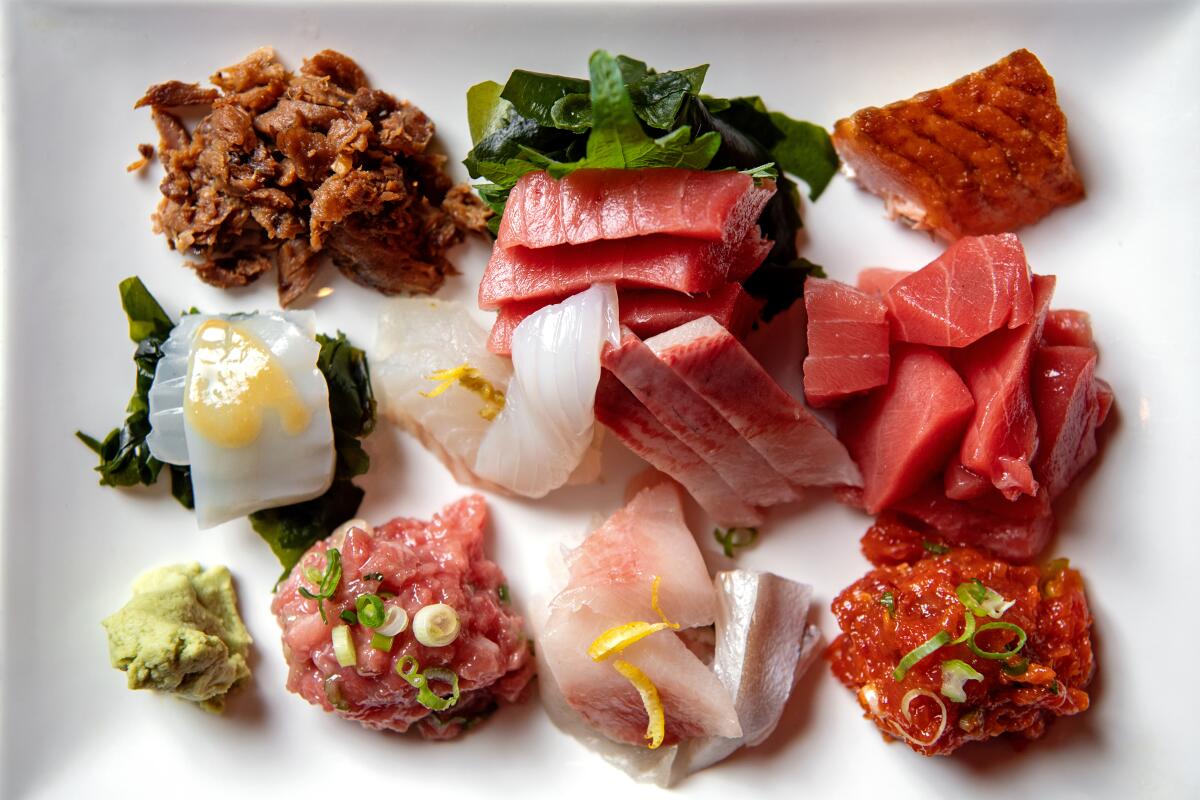
Sushi Gen
Little Tokyo’s best-known sushi bar opened in 1980. Angelenos know it for its popular, photogenic sashimi deluxe platter and its midday crowds. The restaurant doesn’t take reservations and the prime-time wait usually totals no more than 20 minutes. I love the place for its intersection of affordability, efficiency and quality. Sitting at Gen’s counter makes for a far superior and immersive sushi meal than sitting at a table. Chefs provide a list of seafood and gladly interact, making nigiri two or three pieces at a time; if they aren’t buried in a lunch rush, they’ll direct you to some of the most seasonal options — sweet varieties of sea bream or sayori, a pearly-fleshed fish listed as “halfbeak.”
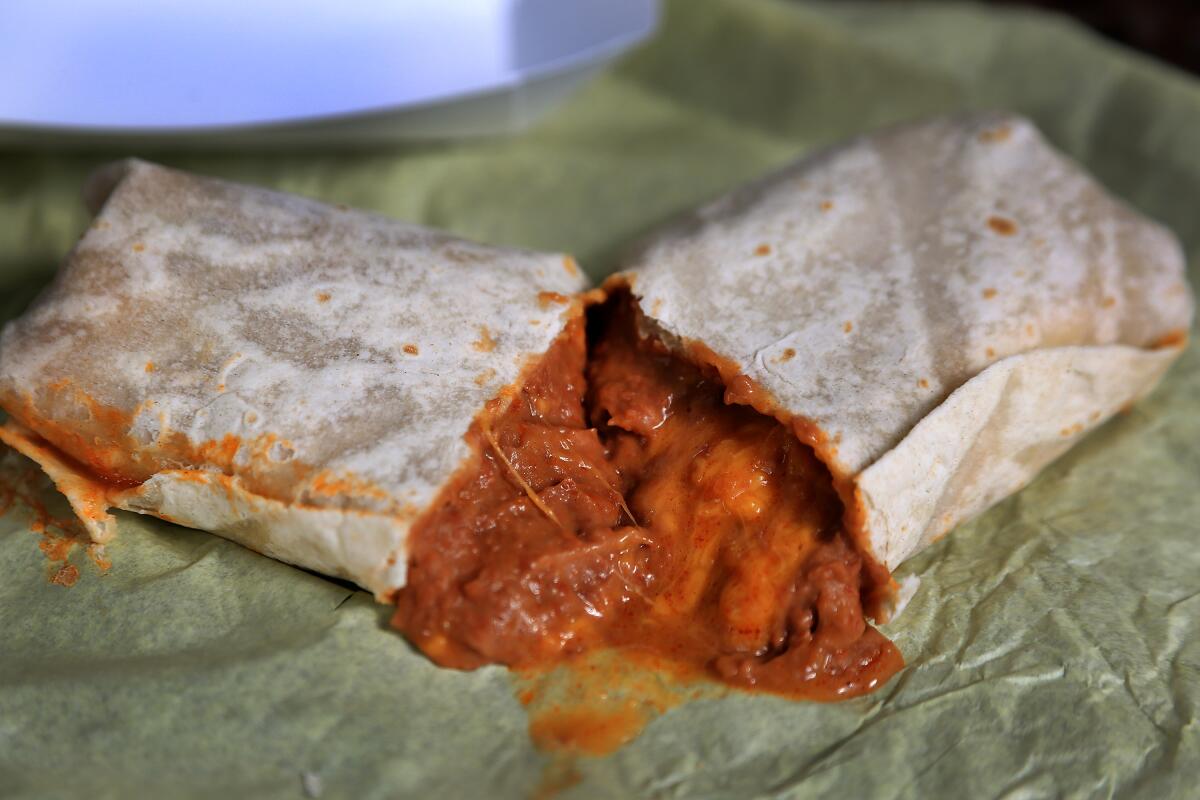
Al & Bea's
Pick up a bean-and-cheese burrito at Al & Bea’s and it wobbles — sloshes, nearly — from the heft of its molten contents. You have a choice of red or green chile sauce; generations of fans have leaned green for its piercing zing. Albert and Beatrice Carreon opened their Boyle Heights stand on 1st Street in 1966; the business is now in the hands of their grandson, Albert Carreon. For either takeout or a quick meal at a shaded table, it remains a heart-of-the-community lunchtime destination for families and nearby workers.
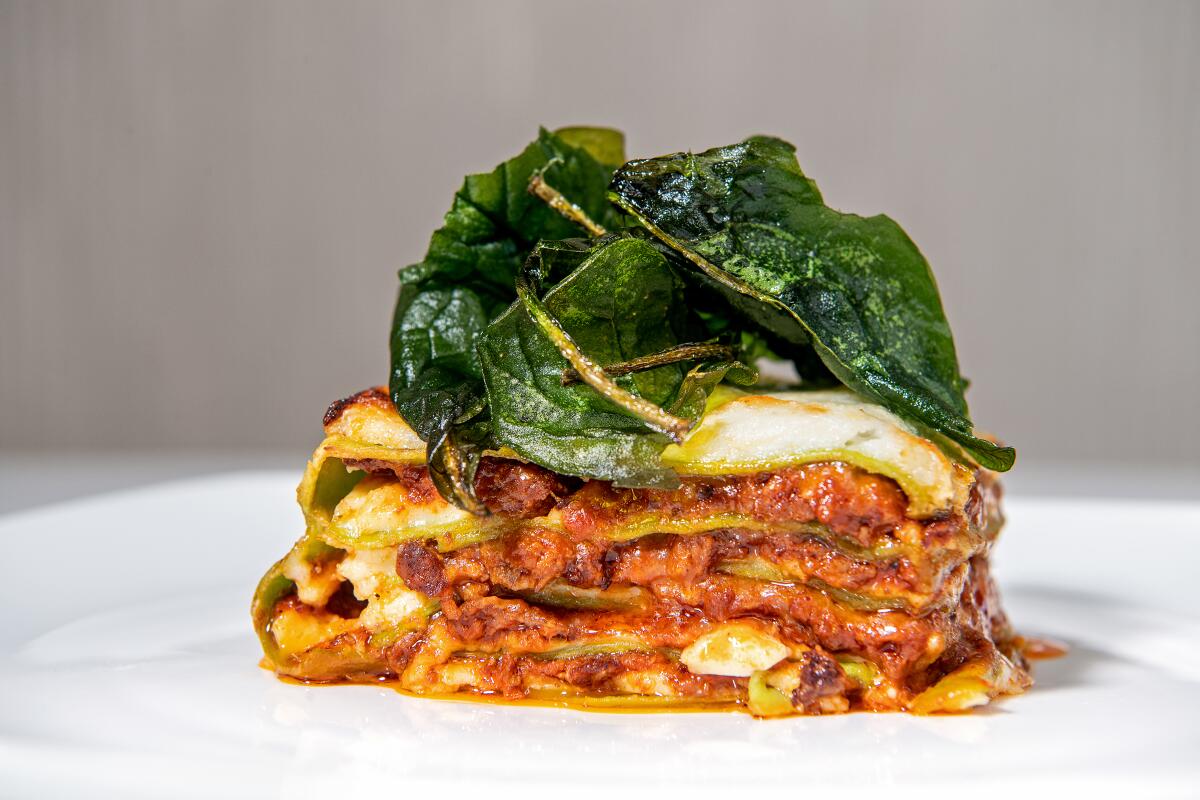
Angelini Osteria
A Beverly Boulevard paragon for more than 20 years, Gino Angelini prepares sophisticated dishes — silky vitello tonnato pinged with fried capers, lamb chops over arugula, a purist’s tiramisu — served in a dining room full of clatter and cheer. His polished repertoire of pastas includes an impeccable lasagna verde and, as a study of subtle textures and layered richness, agnolotti filled with braised veal shank in a Parmigiano-Reggiano sauce. Breakfast is a lesser-known strength; try the eggs in purgatory. Angelini recently opened a second location in the Palisades, but it’s the long-running original that has our enduring devotion. Second location at 1038 N. Swarthmore Ave., Pacific Palisades, (424) 238-5870.
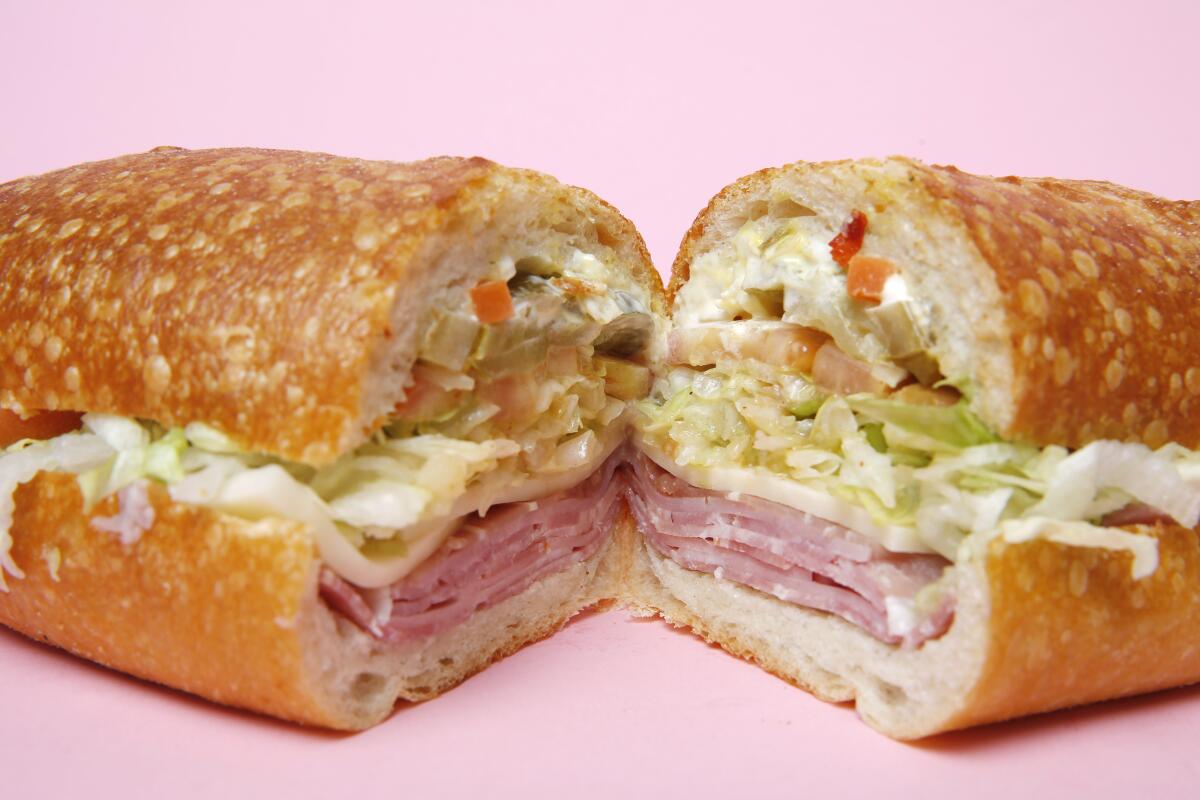
Bay Cities Italian Deli
It’s good time management to pick up a decent bottle of Barolo, a wedge of Parmigiano-Reggiano and maybe some caponata or fusilli pasta salad for lunch later in the week. But we have all come to Santa Monica’s timeless Italian market, which will reach its centenary in 2025, for L.A.’s uncontested queen of subs: the Godmother. A long crackly-topped roll contains sliced prosciutto, ham, capicola, mortadella, salami and provolone stacked with a mason’s precision. Ask for the works, with hot peppers rather than mild.
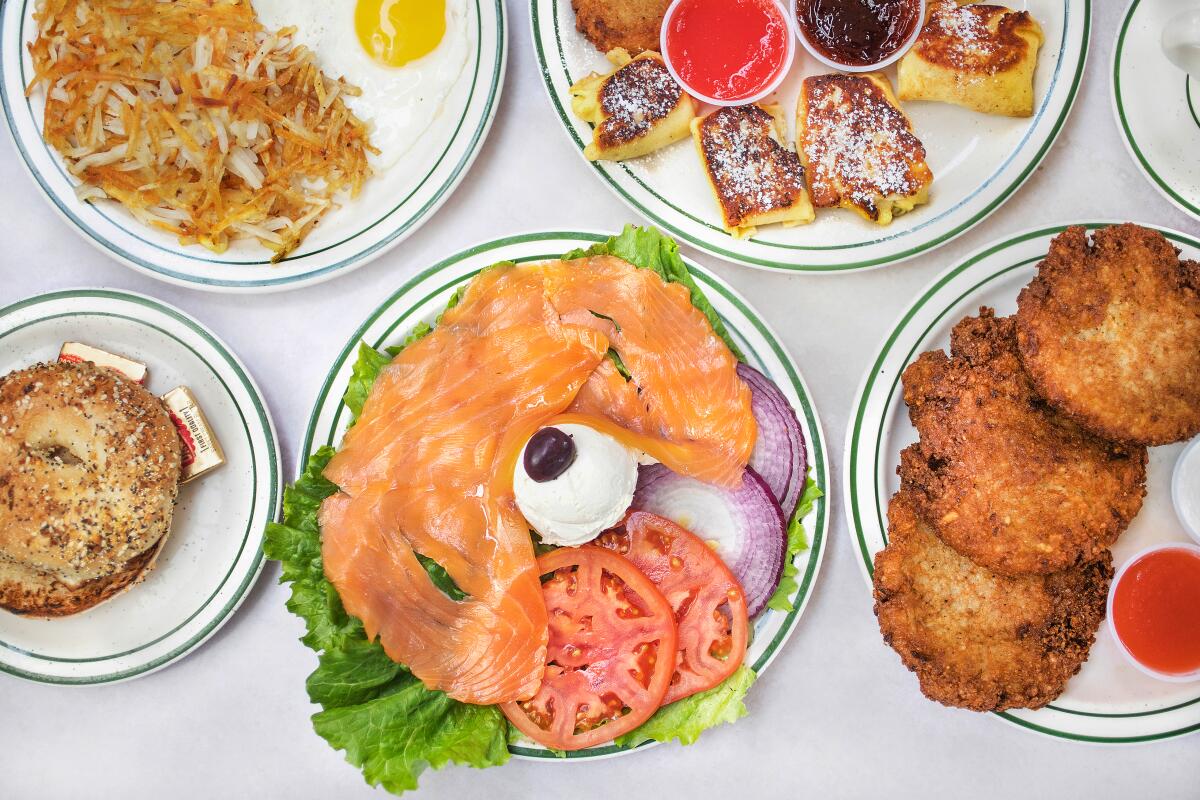
Brent's Deli
Over half a century, since Ron and Patricia Peskin became its operators in 1969, Brent’s Deli has been the Valley’s cornerstone of Jewish deli culture. The conversation only begins with the black pastrami Reuben, the brisket crusted with black pepper and stacked on rye with melted Swiss, hot sauerkraut and Russian dressing. Chicken matzo ball soup, latkes, cheese blintzes and chopped liver are steadfast and eternally comforting. The long room in the original Northridge location feels like an assembly hall; the booths fill first, always. Second location at 2799 Townsgate Road, Westlake Village, (805) 557-1882.
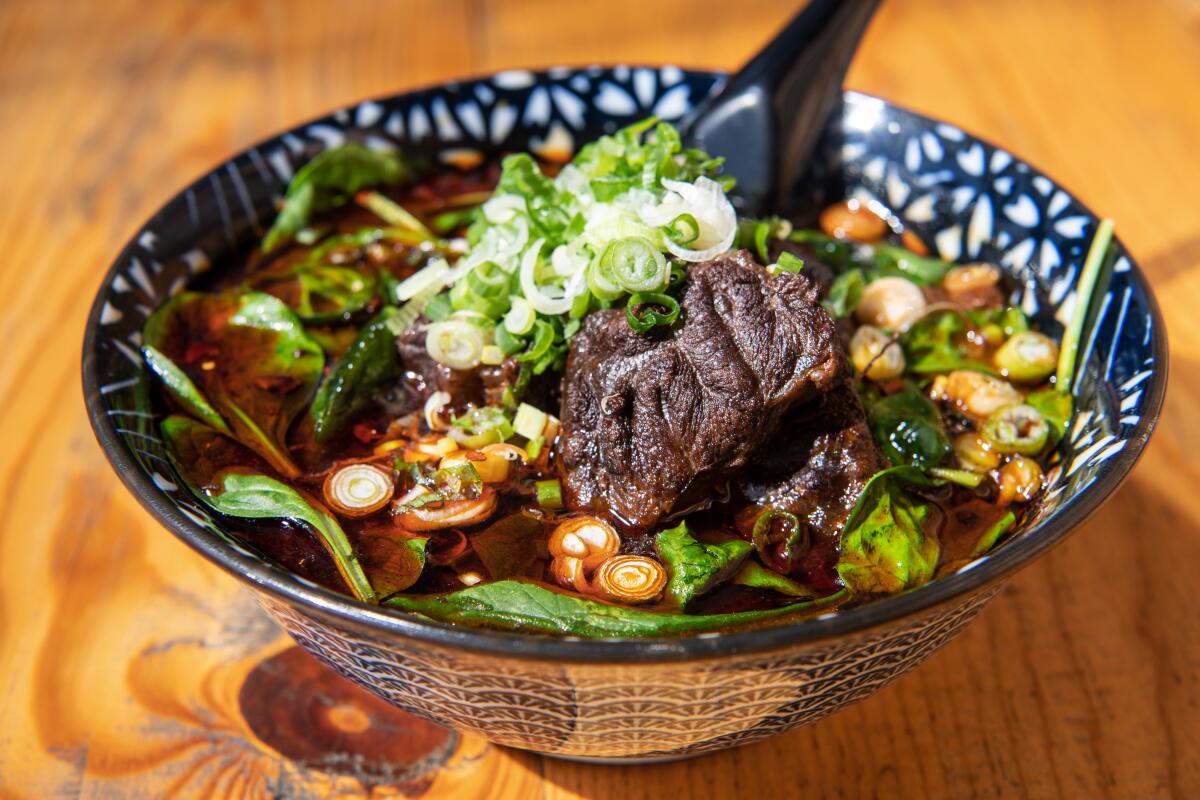
Dai Ho
There’s no lingering at Jim and May Ku’s Temple City noodle shop, open midday for 3 1/2 hours, six days a week. Food speeds out of the kitchen; strangers likely share tables. Most of us show up for the Taiwanese-style beef noodle soup, the Kus’ masterwork. The broth is alive with aromatics and thick with braised beef shank, spinach, a clutch of properly bouncy noodles and a nuclear cloud of house-made chile oil. Start with cold dishes such as garlicky wood ear mushrooms or delicate beef tripe with pressed tofu — or take them with you.
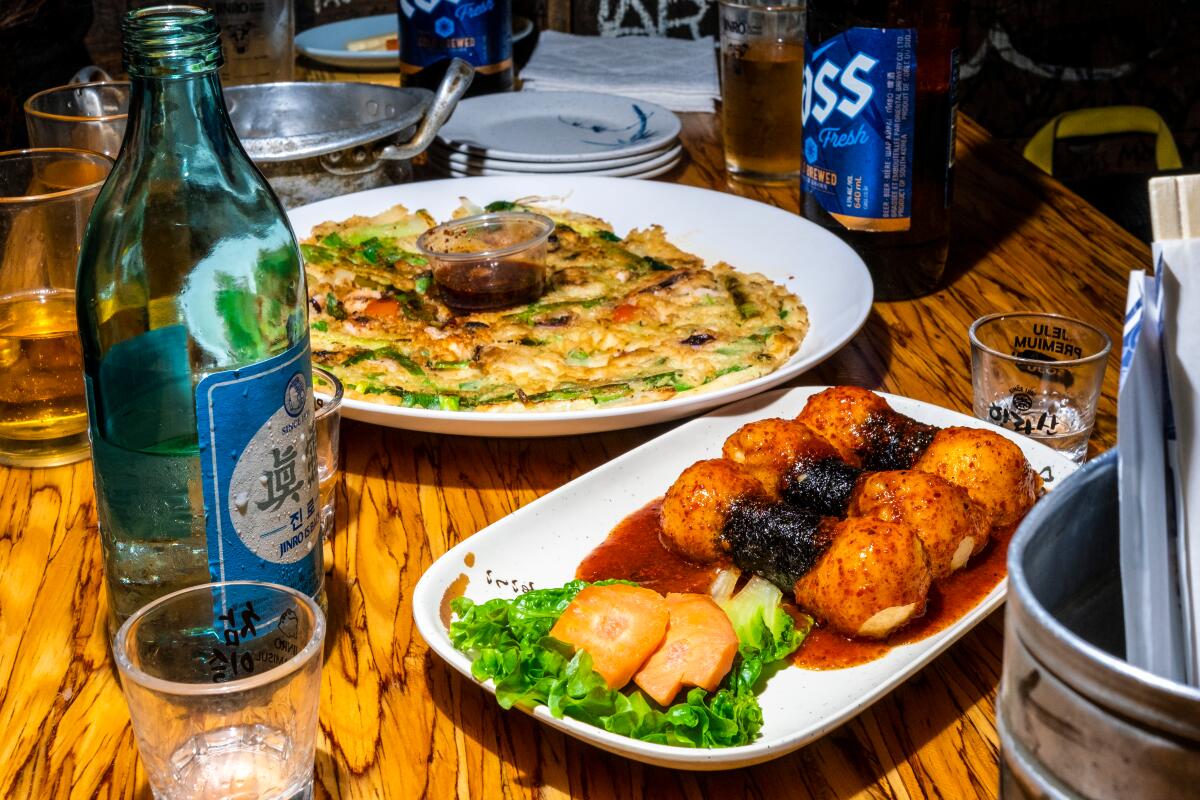
Dan Sung Sa
Behind an inconspicuous wooden door in a Koreatown strip mall with a red brick façade, Caroline Cho runs one of L.A.’s iconic late-night haunts. She modeled the place in spirit after Korea’s tented pojangmacha street stalls, though Dan Sung Sa has its own matchless character: wood-paneled walls gashed with graffiti; a central grill where cooks churn out skewered meats; and Gen X-era K-pop power ballads gushing from the speakers. If one were to compose one of those ideal one-day itineraries for understanding Los Angeles, the night should arguably end here with rounds of soju and a snack of the seaweed-wrapped fried dough known as dumbbells.
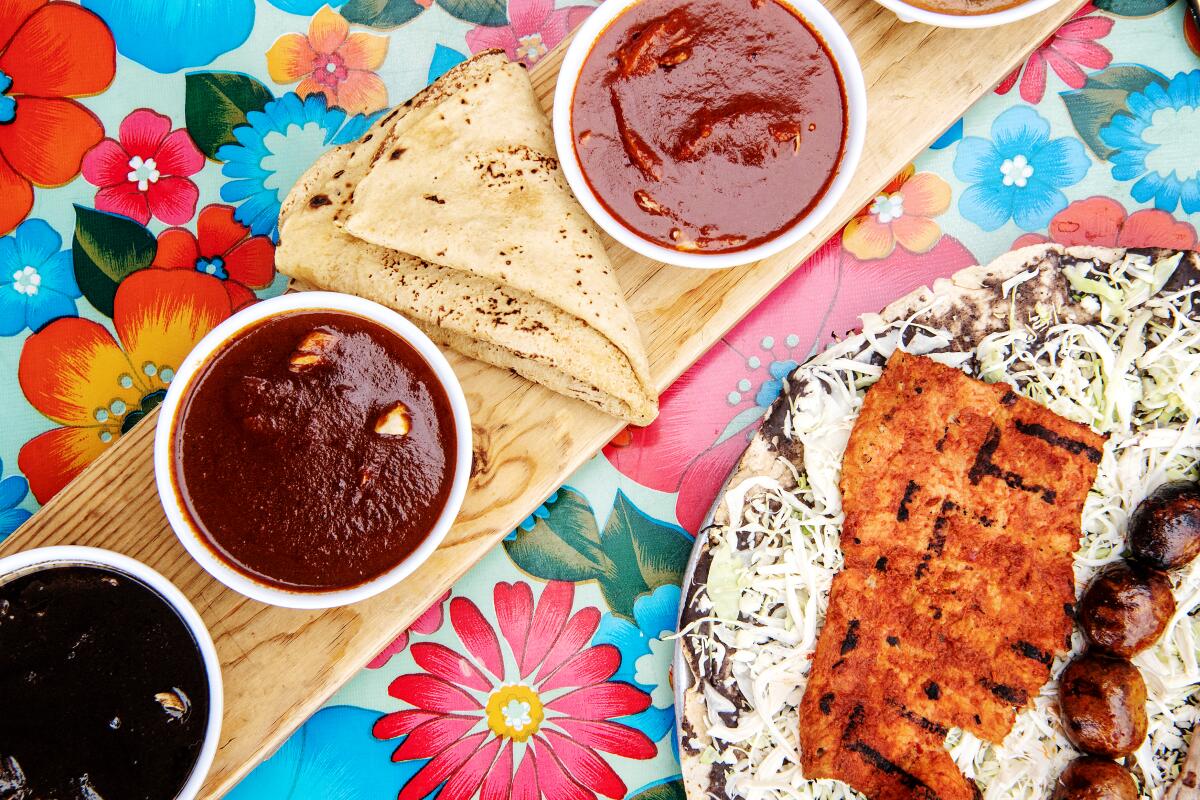
Guelaguetza
At America’s most famous Oaxacan restaurant, founded by Fernando Lopez and now run by his family, the mole negro is as miraculous as ever — a composite of chiles, nuts, plantains, raisins, herbs and sweet and peppery spices merged into a hauntingly delicious whole. In the sprawling, color-splotched dining rooms, multigenerational families share tlayudas wreathed with strings of oval chorizo and barbacoa roja de chivo scented with avocado leaves. Guelaguetza is about more than dining, though. It stands as a stronghold of Oaxacalifornia, an example of achievement and unity in a region that has for decades been home to the largest Oaxacan population outside Mexico.
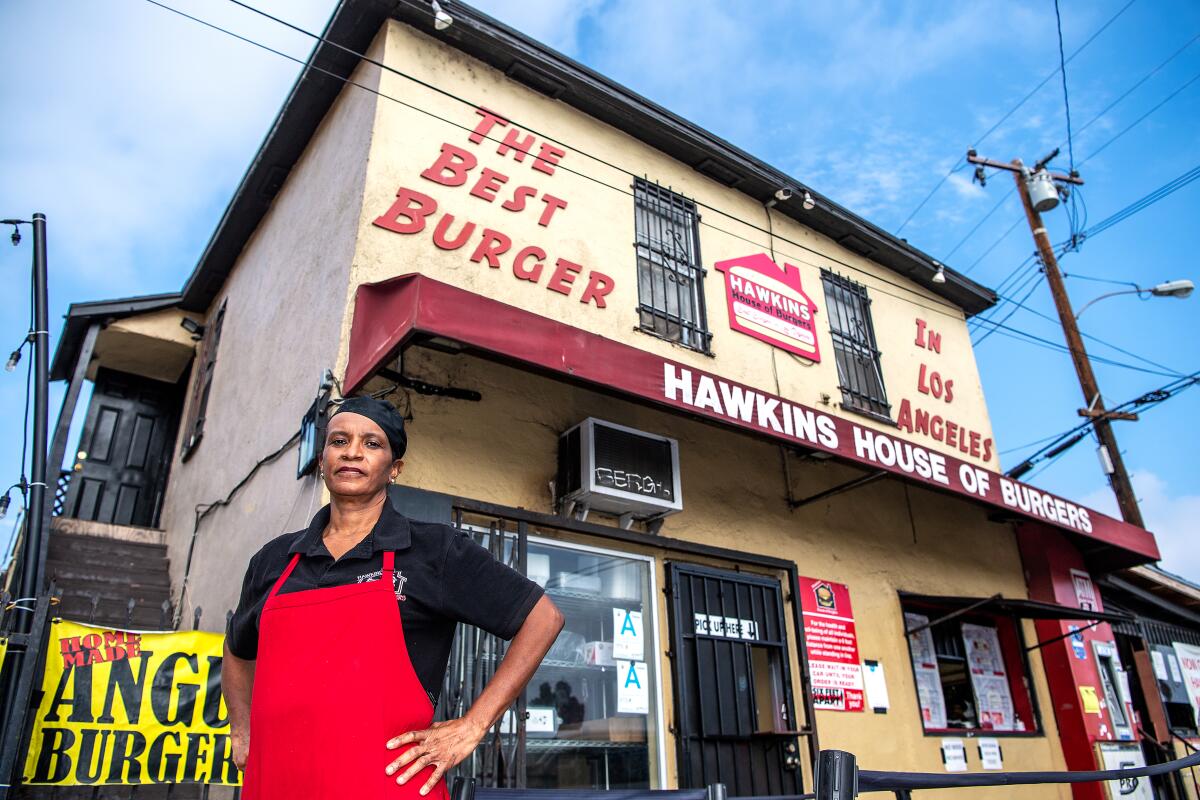
Hawkins House of Burgers
Hawkins’ burgers are thick brutes with charred edges. The toppings that complete them recall park barbecues on holiday weekends. Some lofty creations at this Watts stalwart -- run by Cynthia Hawkins, whose father began the business as a stand in 1939 -- have become signatures over the years, including the Leaning Tower of Watts: 1½ pounds of burger impaled on a skewer with hot links, pastrami and bacon, dressed with egg and chili. No ornate trimmings needed, though: A single-patty model more than holds its own.
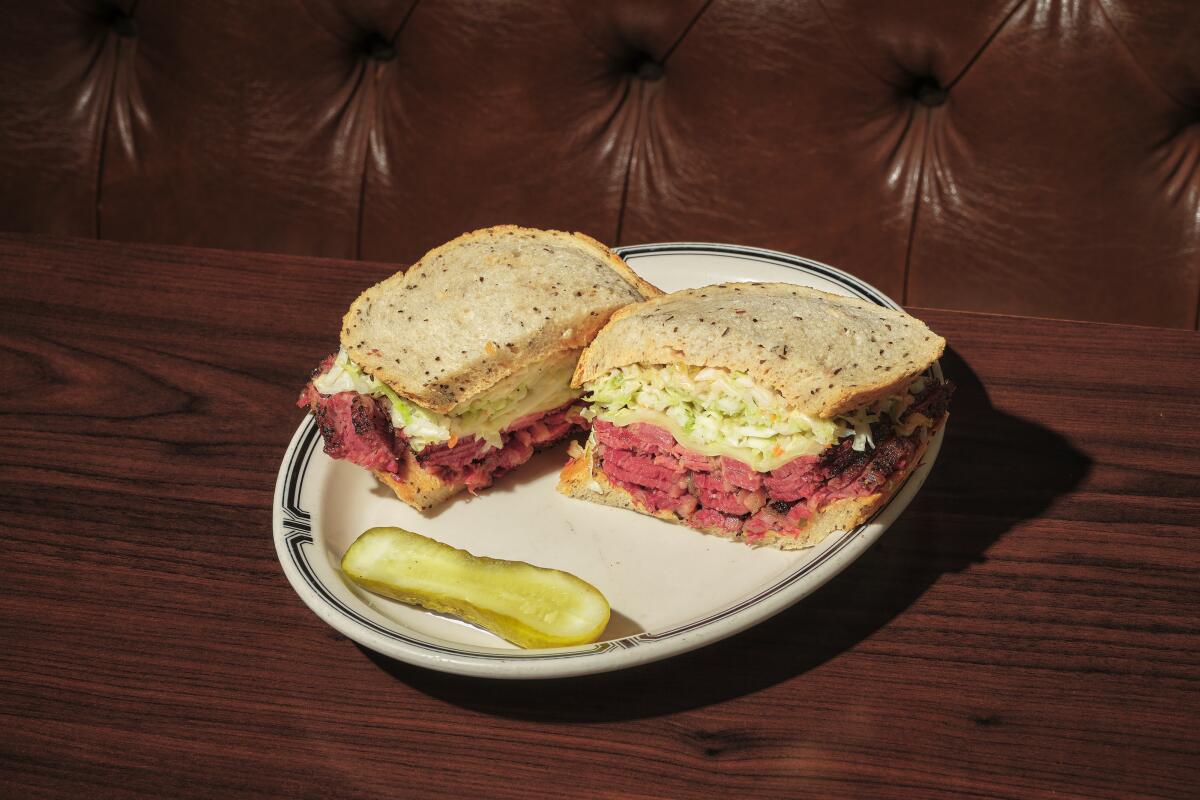
Langer's
The No. 19 at Norm Langer’s Westlake landmark should be named the official sandwich of Los Angeles. The pastrami — brined, peppered, smoked, steamed and shaved by hand into rosy kerchiefs — rises from between two slices of double-baked rye bread. A cushion of coleslaw, Swiss cheese and Russian dressing hovers over top like an upper bunk. Your senses are keener in the face of such perfection. Settle into your chestnut-brown, tufted booth seat among the happy cadences of silverware against plates and myriad languages ringing through the dining room. Honestly, though? Slices of hot pastrami, fanned across a plate with vegetable garnishes and perhaps nothing more than a smear of mustard, show how little adornment the brisket really requires.
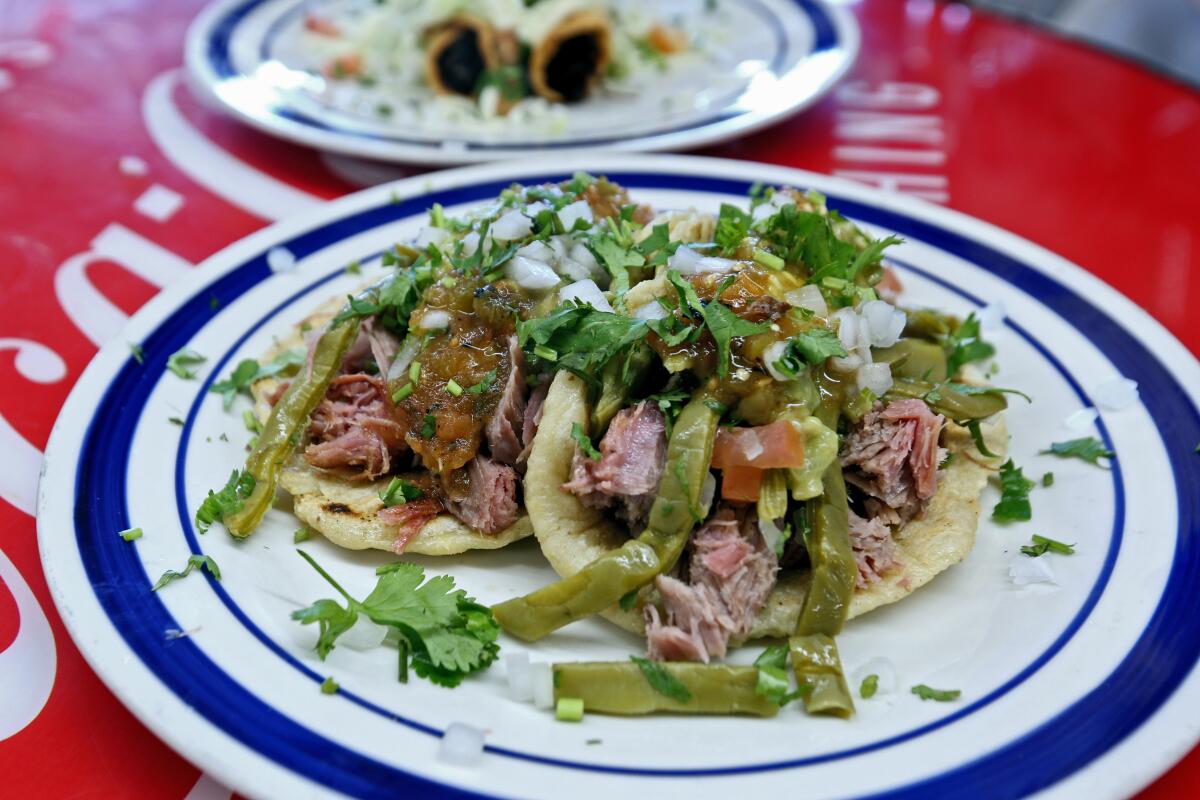
Los Cinco Puntos
Named for the points where East Cesar E. Chavez Avenue, Lorena Boulevard and Indiana Street meet in East L.A., the carnicería and Mexican corner grocery established in 1967 embodies the meaning of “intersection.” Something about the entwined smells in the air — meats simmering and frying, onions, lime juice, masa hitting the griddle — settles the psyche. No matter their errand, most customers walk out holding at least one taco made with a plush handmade corn tortilla. The standard taco choices can be repeated like a mantra: asada, carnitas, buche, lengua, pollo, chile rojo. First-time visitors should start with the carnitas.
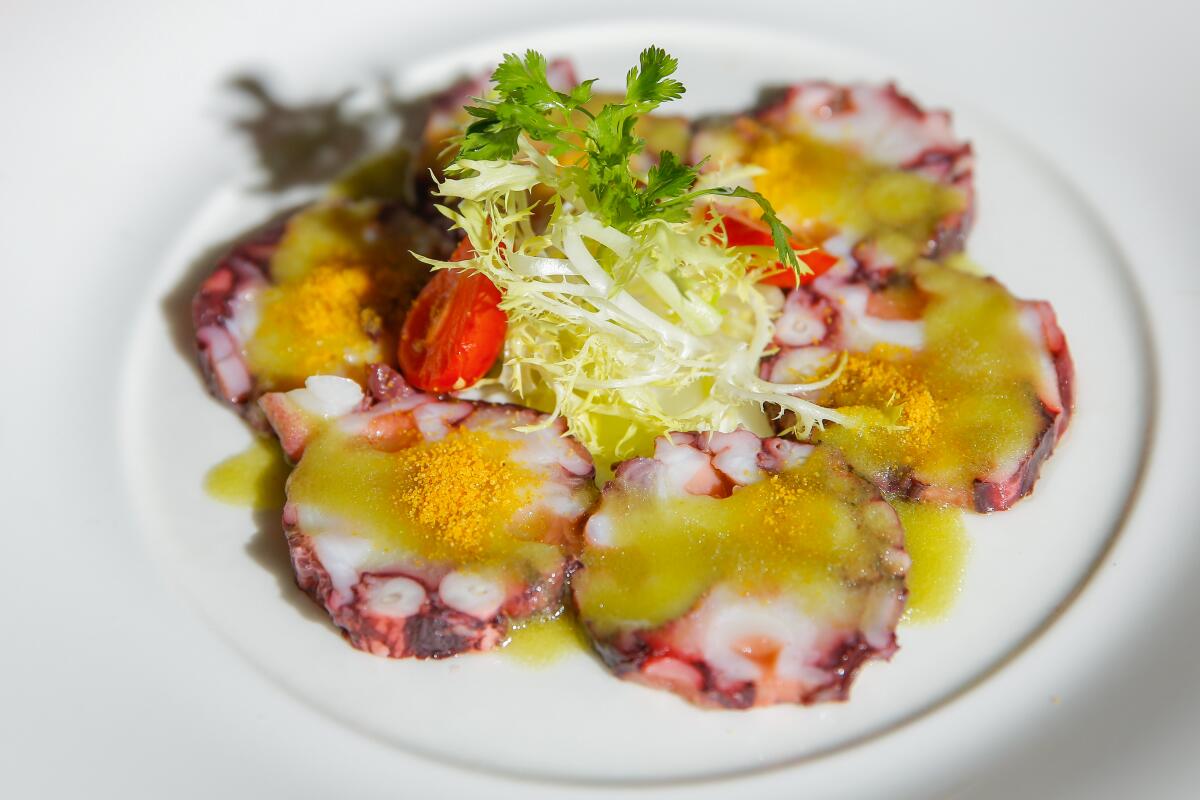
Matsuhisa
How would sushi have evolved in Los Angeles without the arrival of Nobu Matsuhisa’s Beverly Hills restaurant in 1987? It would take a team of oral historians to unravel. He was born in Japan and cooked in Peru and other South American countries before opening Matsuhisa; its runaway popularity led to Nobu in New York and the chef’s ascent as a global brand. His menus have always been interlaced with Nikkei elements, most prominently in ceviches sparked with aji amarillo paste and citrus-drenched tiraditos. The spotlight on his bright, creamy, spicy creations also arguably fell on his time-honored presentations of nigiri. And might his success have also spurred local Japanese traditionalists to double down on serving more historically accurate sushi? In the end, Los Angeles has one of the world’s most energized and varied sushi cultures; plates of Matsuhisa’s ever-satisfying rock shrimp tempura or golden eye snapper with jalapeño salsa, followed by a tekkamaki, remind us where we’ve been and where we are now.
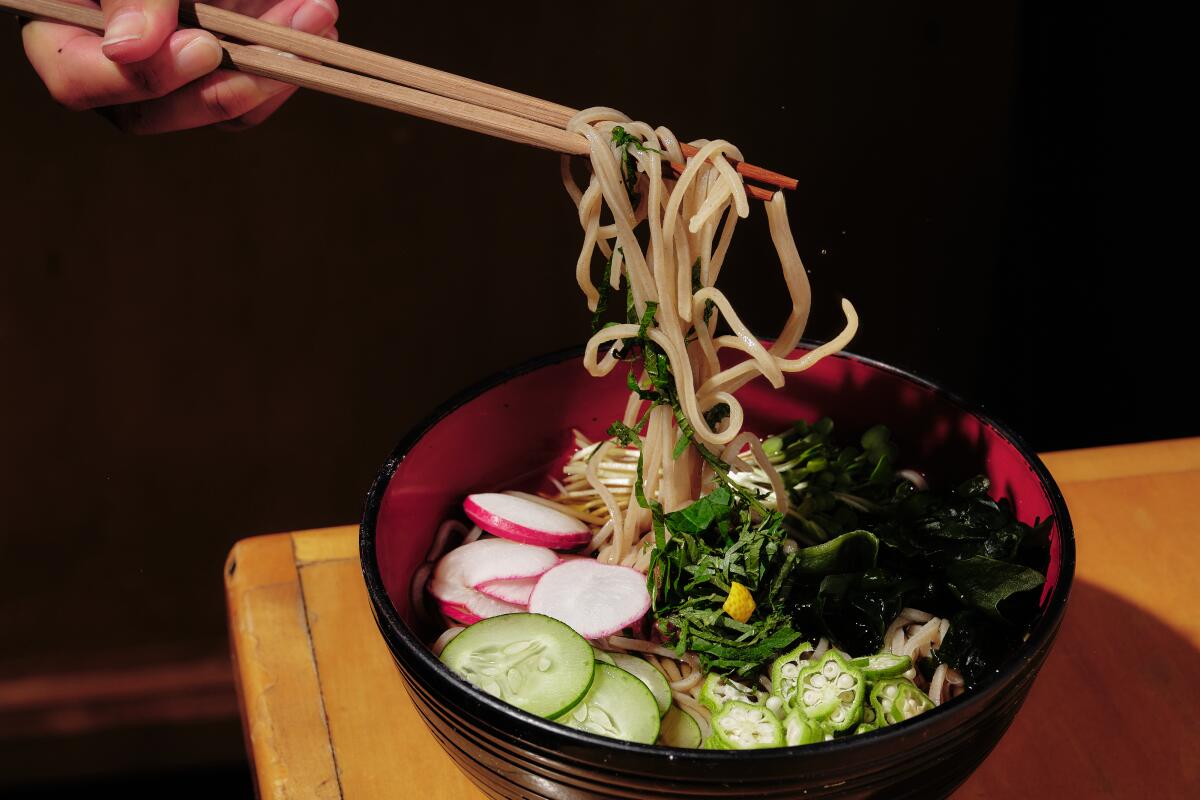
Otafuku
Very few restaurants serve fresh soba — with good reason. Buckwheat flour, the ingredient that gives soba its nutty snap, makes the dough notoriously difficult to form and cut. Seiji Akutsu has practiced the craft five days a week since he and his family opened Otafuku in 1997. He prepares the noodles in three variations, including one that is entirely buckwheat, though the most traditional (and arguably the best) is zaru soba with a ratio of 20% wheat. Try them both hot in soup and served cold on a woven bamboo mat with dipping sauce, and with a side of vegetable tempura. Gardena food lovers know what they have in the restaurant; a steady, easygoing crowd keeps the dining room full for lunch and dinner.
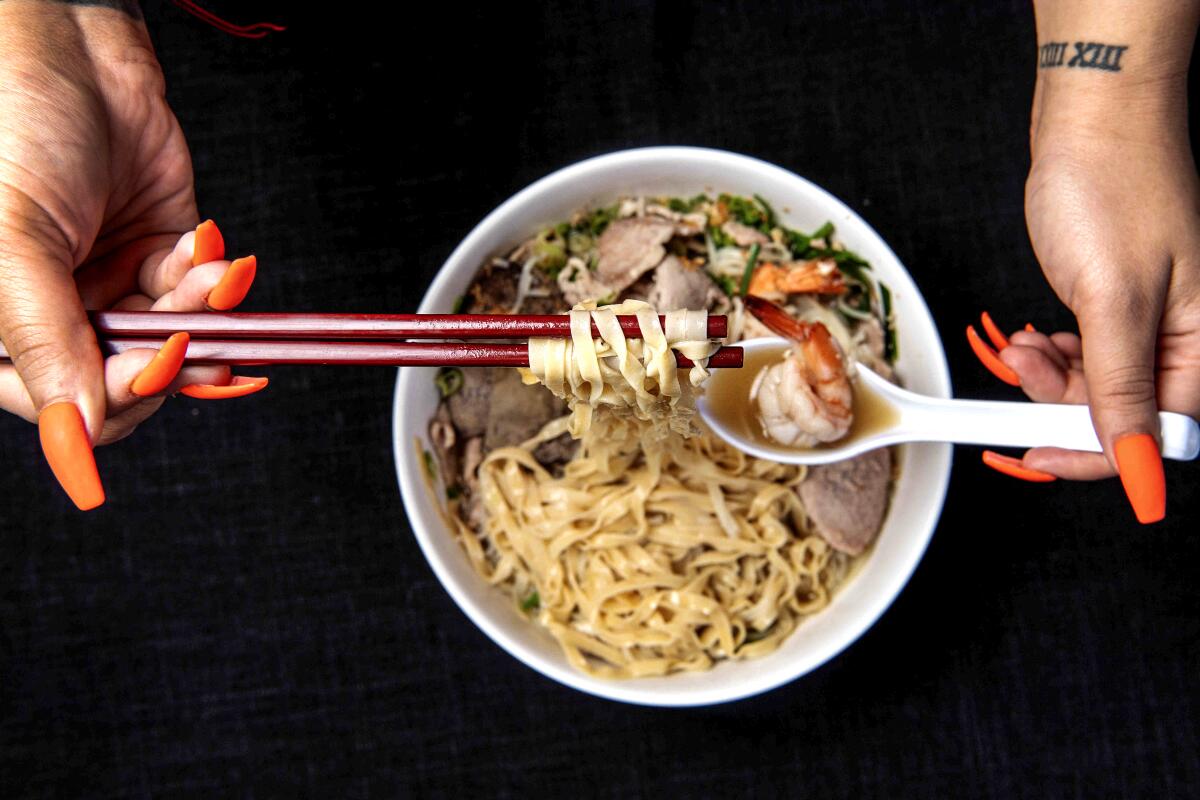
Phnom Penh Noodle Shack
Any conversation around the dining culture in Long Beach’s thriving Cambodian community begins with this restaurant opened by the Tan family in 1985. Kuy teav, the reason people wait mornings and afternoons for a table, is a highly customizable breakfast soup built around various shapes of rice or egg noodles and pork broth. The multitextured “house special” includes several cuts of pork and shrimp given even more nuance with the optional mixed noodles. Be generous with additions of fried garlic, scallions and squeezes of lime.
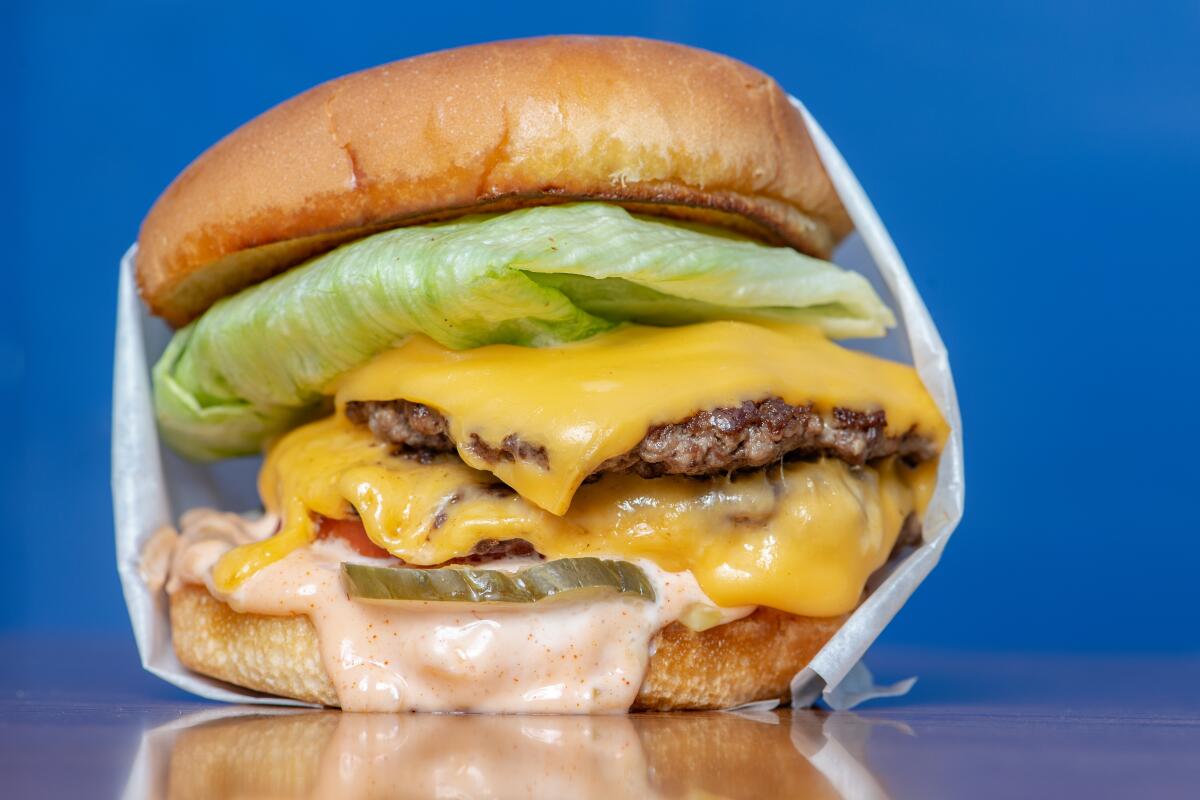
Pie 'n Burger
With respect to the many aficionados who would name the icon served at Apple Pan as the quintessential California burger, I contend that the title belongs to Pie ‘n Burger’s Big Ben. Chunky slices of tomato and onion; twin medium-thick patties, griddled to crispness; American cheese squares melting at their pointed corners; a wad of iceberg as bulky as an oil tycoon’s billfold; a vaulted bun: This is earthquake-proof construction, built to last the ages. The wax paper wrapper is more for a clean grip than for engineering purposes. True to the restaurant’s name, completionists won’t leave their low seat along the counter without downing a generous slab of pie — lemon meringue, perhaps, or strawberries when they’re in season.
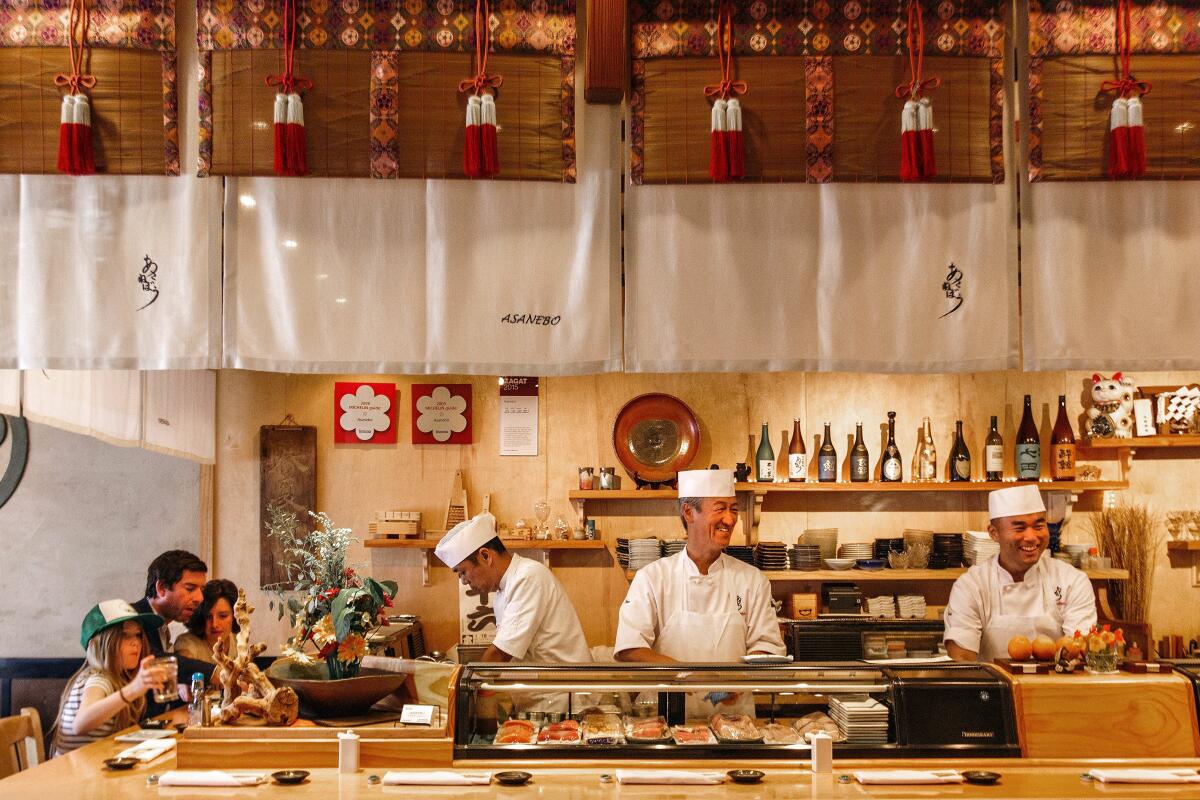
Asanebo
Asanebo’s easy versatility is the key to its 28 years of success among the competitive klatch of Studio City sushi bars. Swinging by after work for a bowl of edamame, a spicy tuna roll and a few grilled chicken wings marinated in miso? Warm smiles all around from the staff. Or make it a more lavish night out with omakase, priced in three tiers, where house-made tofu with snow crab may precede plates of nigiri and, at the higher end, Hokkaido scallops gilded with shaved truffles.
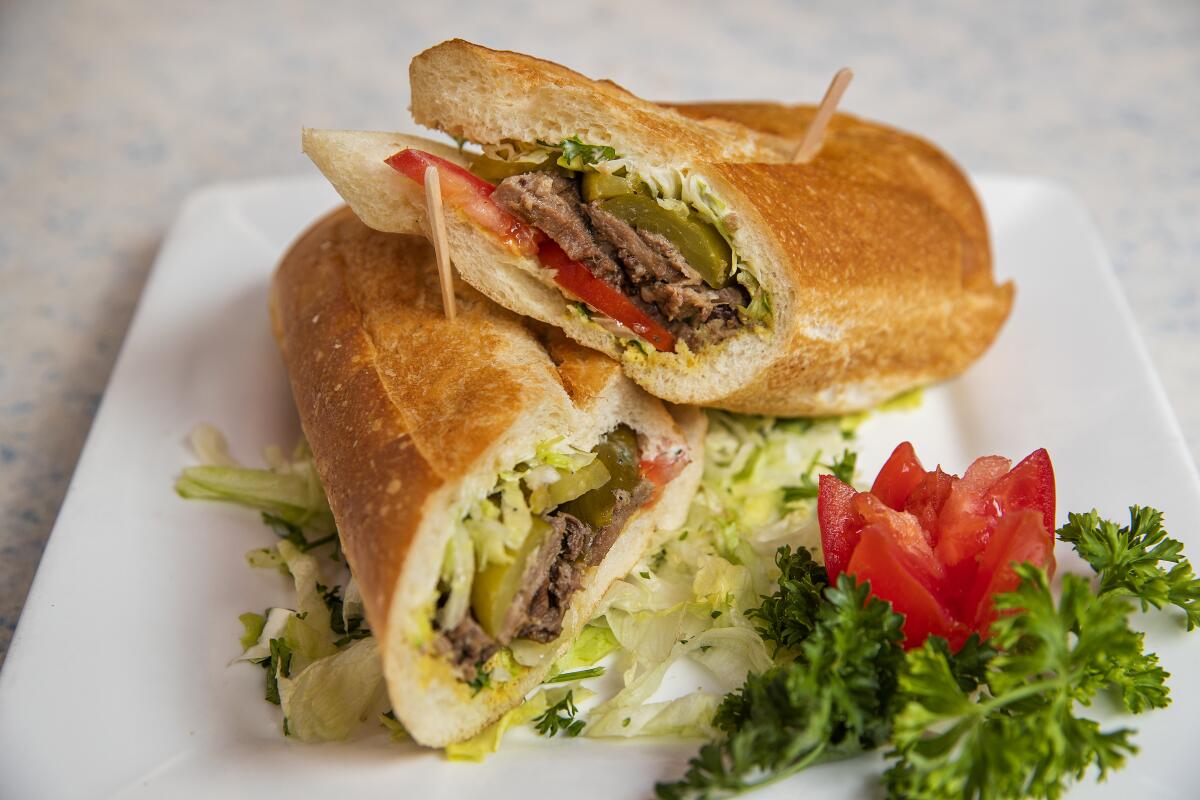
Attari Sandwich Shop
This Persian Square cafe is a trove of excellent Iranian home-style cooking. The thick kuku sabzi is a savory herb-green omelet tucked into a soft French-style roll. We love the beef tongue sandwich, a meaty, voluptuous muddle of tender beef, crisp lettuce and piquant pickles. Pair any sandwich with the garlicky spinach-lentil soup called osh. On Fridays, try the braised lamb dish ab-goosht, served with a split yellow pea mash, warm flatbread, pickles and fresh herbs. Scooping up meat with the bread, garnishing it with veggies, herbs and pickles, turns a prosaic lunch hour into ceremony.
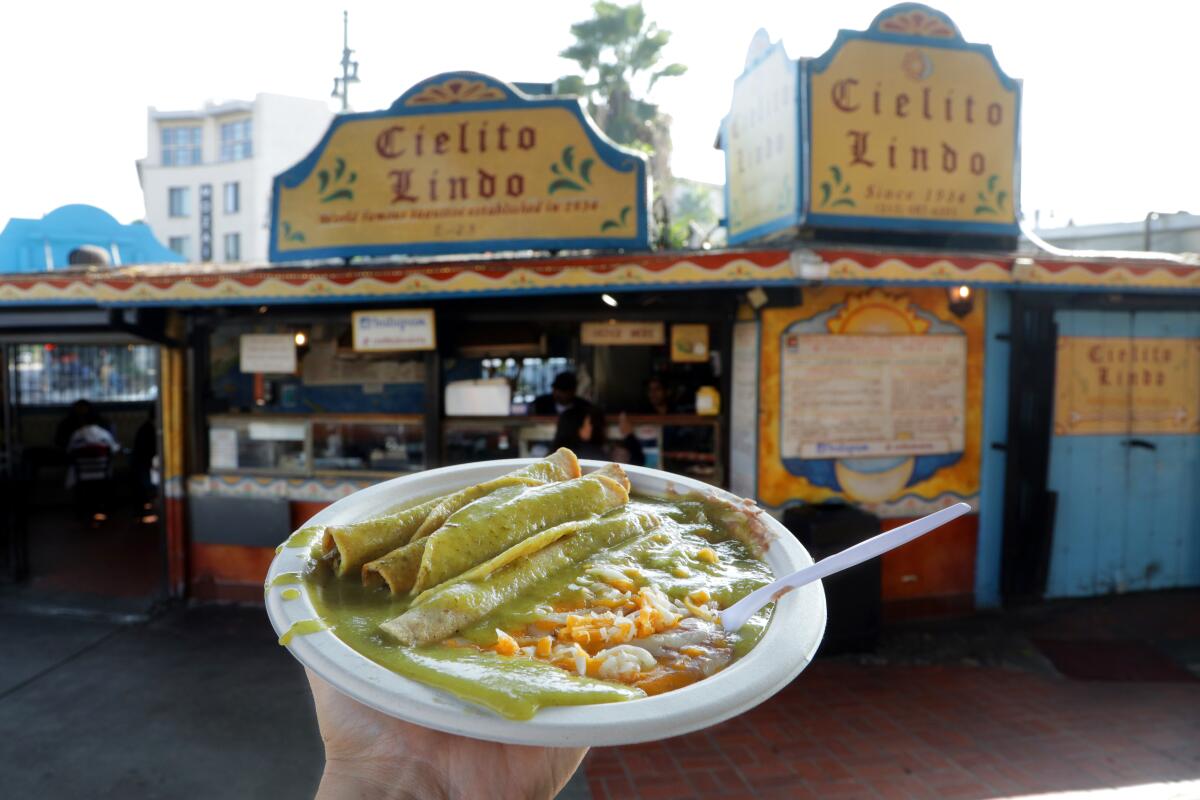
Cielito Lindo
The Olvera Street taqueria founded by Aurora Guerrero in 1934, who named her business after an 1880s-era song favored by mariachis, is known for one enduring specialty: beef taquitos, pan-fried in batches until the rolled tortillas seize into crispness. They come doused in mild tomatillo-based avocado sauce; the pleasure is in scarfing down the taquitos while they retain their crunch, even as the salsa begins to seep in and soften them. Guerrero’s granddaughter Diana Robertson carries on the family legacy with her sisters Mariana Robertson and Susanna MacManus. They operate a second takeout location at 1806 N. Broadway. Especially after the 2020 pandemic-related closures, though, it’s an easy joy to show up at the original location, stand in the fast-moving line and sit in one of two small dining areas that flank the stand’s counter. Taquitos weren’t designed to wilt in to-go containers.
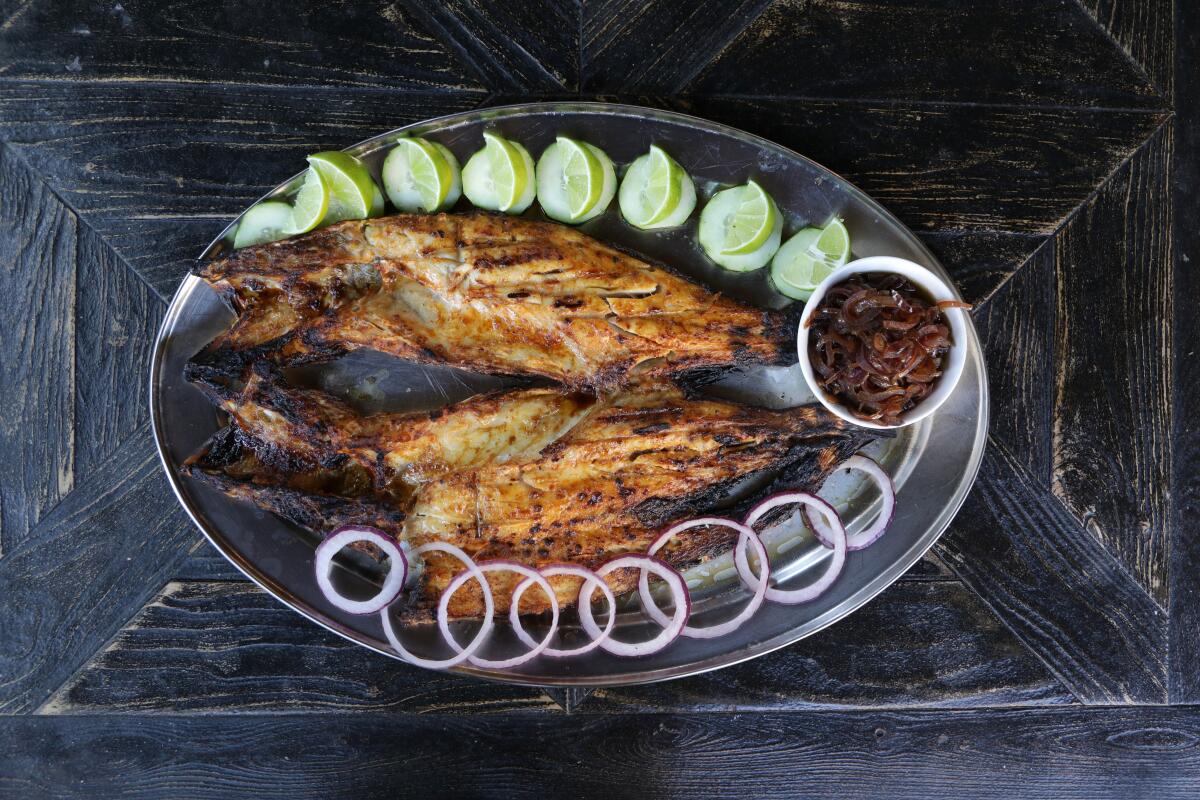
Coni’Seafood
Vicente and Connie Cossio founded Coni’Seafood in the late 1980s in the backyard of their Inglewood home, eventually growing the small marisqueria into what would become Coni’Seafood, a restaurant that probably has done more than any other to popularize classic Nayarit-style coastal cooking in Los Angeles.
Bring friends and order the pescado zarandeado, crisp-edged, slow-grilled snook marinated with fresh citrus, chiles and mayonnaise. If you favor bold flavors, the aguachile — big, head-on shrimp marinated in a spicy citrus marinade — is excellent.
For pure comfort, try the snacky fried tacos stuffed with smoked marlin, or the tostaditos, mini tostadas paved with a marlin pâté and layers of minced shrimp and octopus. Second location at 4532 S. Centinela Ave., Los Angeles, (310) 881-9644.
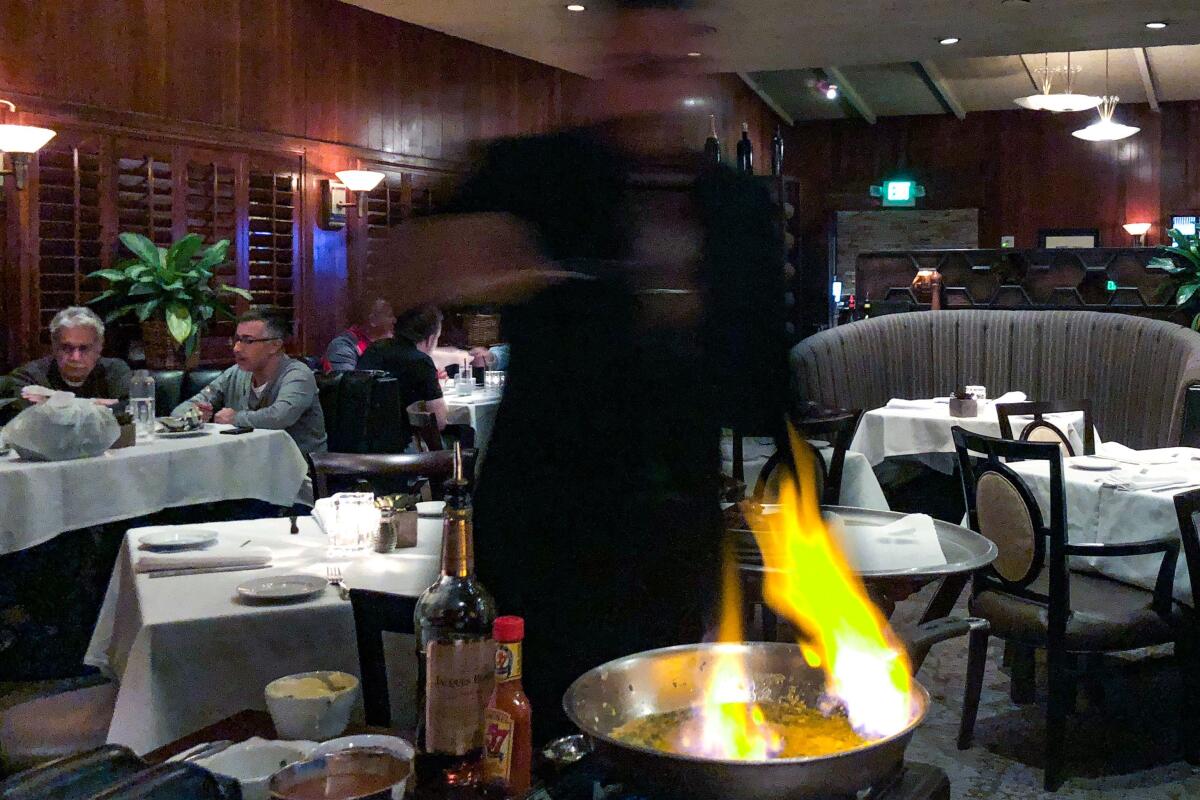
Dal Rae
Dal Rae opened in Pico Rivera in the 1950s, and the wood-paneled dining room transports you back to the post-WWII boom. Baked brie with pesto and sun-dried tomatoes is about as avant-garde as its menu of Continental classics swings. You’re here for tableside action: the Caesar salad tossed in a giant wooden bowl and steak Diane complete with a dramatic glug of brandy set ablaze. Dessert is a pouty Grand Marnier or chocolate soufflé. L.A. is blessed with many throwback restaurants; Dal Rae’s savoir faire and exuberance distinguish it from the pack.
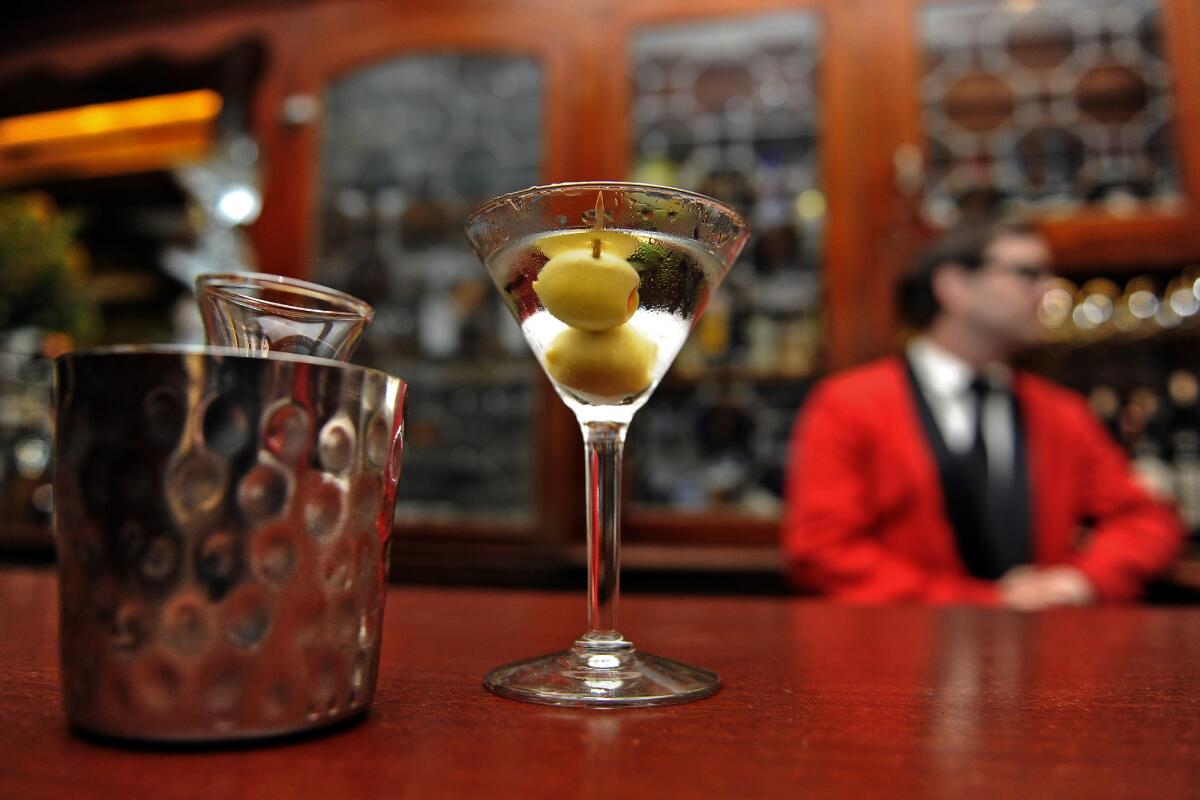
Musso and Frank Grill
Tinseltown’s landmark restaurant turned 100 years old in 2019, on the heels of its lstar turn in Quentin Tarantino’s “Once Upon a Time ... in Hollywood.” The film’s title is an apt billing for Musso’s, as everyone calls it, since time is a malleable concept within its smoke-stained walls. Immortal servers glide past rows of red leather booths, delivering shivery martinis, stirred and never shaken, to screen legends, literary giants and the rest of us. How are the grilled lamb chops, the rib-eyes, the Welsh rarebit? Good enough. What’s most important is the existence of the restaurant itself, classy and immutable.

Newport Seafood Restaurant
Wendy Lam and Ly Hua graft their Cambodian-Cantonese culinary roots with Vietnamese and Thai flavors for the sprawling menus at their two SGV restaurants. The union is best showcased in their famous spicy lobster, flamed in a wok’s inferno with garlic, ginger, jalapeños, green onions and black pepper. Their bo luc lac (Vietnam’s “shaking beef”) and steamed spot prawns are flawless in their simplicity. Go early or late, especially on weekends, to avoid long lines. Second location at 18441 E. Colima Road, Rowland Heights, (626) 839-1239.
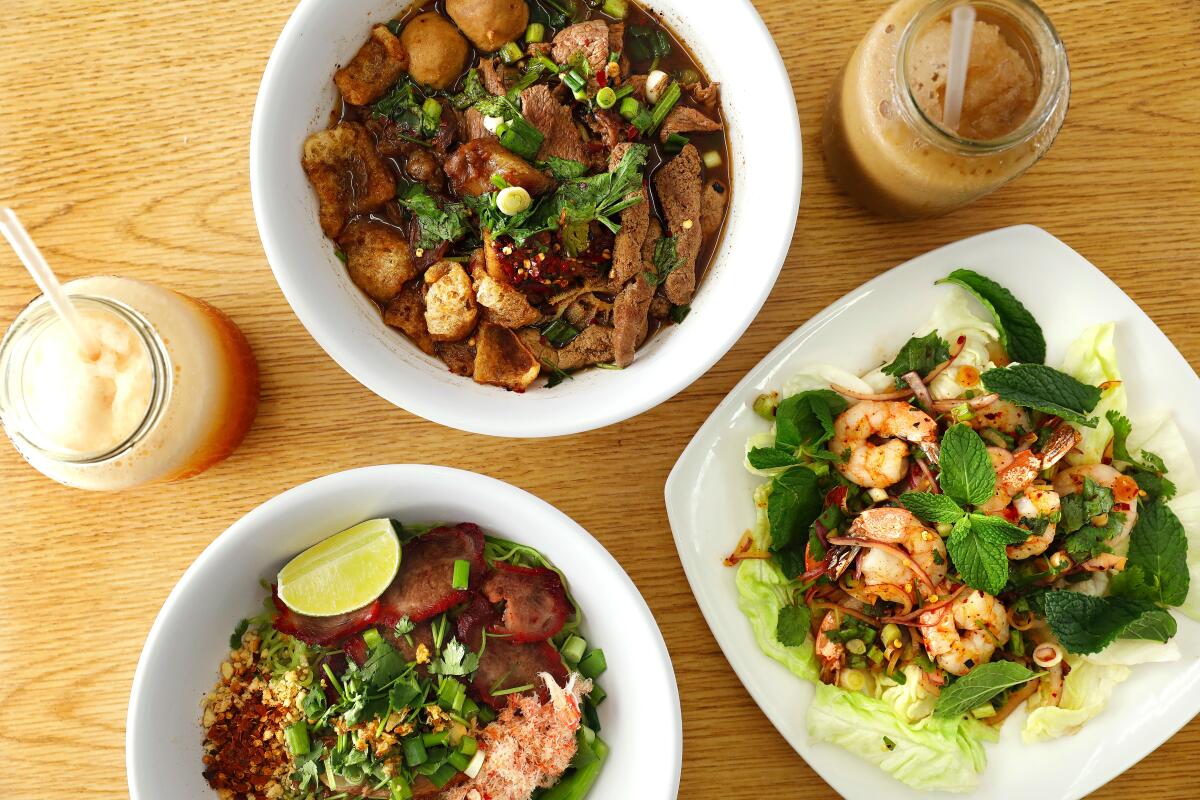
Sapp Coffee Shop
This cash-only Thai cafe rewards repeat visitors with a dizzying selection of a la carte options, but the thing to get at least once is the savory boat noodle beef soup with everything: The cloudy stew, thick with offal bits and buzzing with chile heat, is profoundly meaty. A dish of jade noodles tossed with crab meat and slices of roasted duck and barbecued pork is layered with sweet, salty flavor. Fried egg with pork belly is less nuanced but it makes a good breakfast, as does the ground pork omelet over rice. For a caffeine lift, order a frosty Mason jar of strong Thai iced coffee.
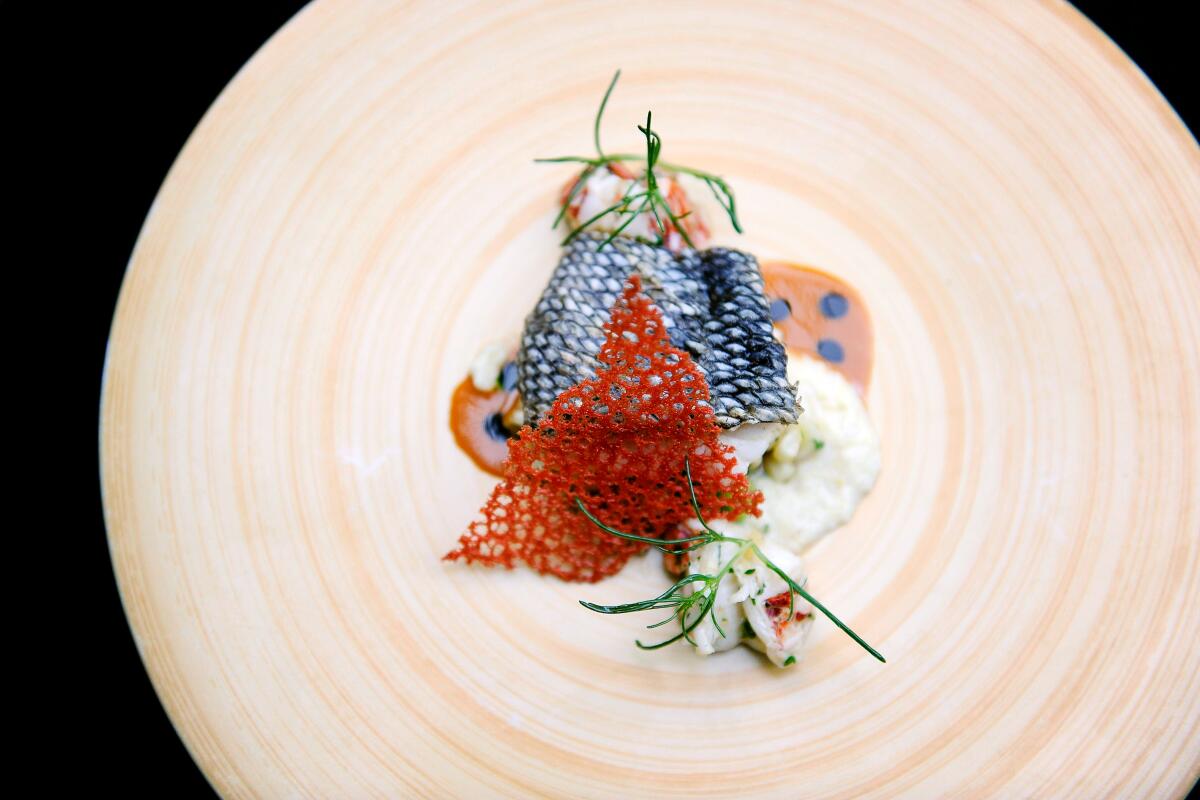
Spago
Power, celebrity, a sense of occasion, late 20th century glamour, smoked salmon pizza: Few restaurants need less of an introduction than Wolfgang Puck’s Beverly Hills flagship. Vie for a table in the energized main dining room. Indulge in corn-filled agnolotti and crispy-scaled black bass with rich sauce Americaine (and order a pizza while you’re at it). The pièce de résistance is pastry chef Della Gossett’s kardinal schnitte, a cathedral of a dessert built on sponge cake, meringue, layers of custardy strawberry-white chocolate crème and the ripest Harry’s Berries strawberries. Spago pioneered casual fine dining in L.A. It will always have its audience.
Eat your way across L.A.
Get our weekly Tasting Notes newsletter for reviews, news and more.
You may occasionally receive promotional content from the Los Angeles Times.
